

50 The Help (2011)
Discrimination in the help.
By Alexia Privratsky
Imagine washing dishes and caring for another woman’s children all day, every day, with little to no appreciation or recognition; feeling like the children are your own, due to the fact that you practically raised them. Imagine being an African American woman in Jackson, Mississippi in the 1960s, working as a housemaid, when the civil rights movement was in full motion. Jim Crow laws prohibit you from entering the same stores as white people, sitting in the same bus seats, using the same restroom, and even going to the same schools. You live a life entirely separate from that of white people, yet they still allow you in their home to work for them. This depiction of the lifestyle of African American housemaids in the 1960s is portrayed in the movie, The Help . This movie is about a young woman, named Skeeter, who recently graduated college and has returned to her hometown, Jackson, Mississippi, to work on a project for her career as a journalist. The other white women that are the same age as Skeeter refer to their housemaids as “the help,” who are predominantly African American women. The treatment that the maids receive from the white women sparks unsettlement in Skeeter’s gut, giving her the idea to write a book about the relationship between housemaids and Southern white women. Skeeter eventually has numerous of the housemaids agree to tell her their stories, from which eventually Skeeter is able to publish a book. The main purpose of this movie is to portray the reality of racial discrimination in the 1960s. The Help , overall, effectively portrays the magnitude to which racial discrimination impacted the lives of many African Americans in the 1960s through the use of specific visual and audio techniques, including editing, sound design, mise en scene, cinematography, and visual design.
During the 1960s, when The Help is set, the civil rights movement had begun to run full force. At this time, people were protesting, sit-ins were taking place at restaurants, the Little Rock Nine made a bold move attending an all-white high school, Rosa Parks got arrested for not giving up her seat, and so on. African American people were pursuing change in the world and were tired of the consistent discrimination that they faced. The director, Tate Taylor, and the producers of The Helpwanted to portray the racial discrimination that many African American women faced on an everyday basis, that was not always talked about in the media. The Associate professor of Theater at Tufts University, Monica Ndounou, states the filmmakers’ purpose as well when she states in her book, Shaping the Future of African American Film , that “the black female protagonists in each film are intended to appeal to female audiences across color and class lines on the basis of women’s issues.” This shows that not only were the filmmakers of The Help seeking to portray issues of race, they also included issues regarding women’s rights. The filmmakers were able to convey the importance of the historical component of the movie through using film elements as well, such as mise en scene. The filmmakers created each set to include specific details, such as in the white womens’ homes the scenes had expensive decorations and looked virtually perfect while when the scene shows one of the black womens’ homes, it is not as nice nor particular (12:06 and 41:01). This detail that the filmmakers included also entails the historical importance of the impact that racial discrimination had on class standing. Since black families were not able to pursue the same careers or education that white people had the opportunity to, they often lived very simplistic and poor lives. Overall, this film portrays a very important time in history when minorities were finally embarking upon freedom and independence.
Through the historical component of this film, viewers are also able to determine instances of difference portrayed. The filmmakers were trying to exhibit the large social gap between African Americans and white people during this time period; they accomplished this through including scenes that show the difference in housing, clothing, lifestyles, and careers that different racial groups had. For example, at 8:21 in the film, Hilly, her mother Missus Walters, and Minny are walking down the sidewalk. In this scene, the camera makes a following shot, meaning the camera follows the characters’ movement to keep them in the frame.
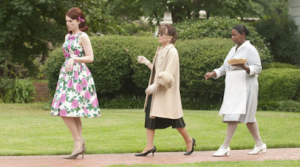
This technique accentuates the clothing that each character is wearing: Hilly and her mother are wearing nice dresses and heels while Minny is wearing a maid’s uniform. This technique peaks the attention of viewers at each character’s outfit, and shows the drastic difference that their social classes are through the things they are wearing. Another instance of how the filmmakers portray examples of difference in the film is seen through Skeeter’s character. Although Skeeter is a white woman, she is still widely different from her peers. Exactly like Carol Miles, a professor at the University of Nebraska Omaha, states, “from [Skeeter’s] untamed curly locks to her practical shoes, and seeming lack of interest in marriage and starting a family, she is unconventional by the standards of the day and among her peers.” The filmmakers purposefully create Skeeter’s character to be an outsider to justify her decision of completing illegal acts, such as when she listens to the black womens’ testimonies regarding the treatment they receive from white people (56:26). Due to the time period exemplified in The Help , the filmmakers worked very hard to distinctively portray differences among the black and white characters. Without these differences, the stark laws regarding interracial friendships would not be as understood by the audience. Not only was it dangerous for black and white people to become friends in the 1960s in Mississippi, like Skeeter did with the maids, “it was dangerous in Mississippi for whites and blacks [to even] talk about racial oppression” (Denby). The portrayal of difference in this film has such a heavy importance that without it, the civil rights movement of the 1960s would be inaccurately represented.
Not only are instances of difference among the characters important in the film, instances of the amount of power that different characters have is as well. The filmmakers of The Help crafted each character’s socioeconomic standing to represent the amount of power that they had in society. For example, due to the fact that the maids worked for the white women, they were often treated as if they did not have any power in society at all. At 32:24 in the movie, Hilly and Minny have an argument about Minny using Hilly’s restroom, which leads to Minny getting fired. In this scene, the amount of power that Hilly has is seen through the sound design in the film; when Hilly screams at Minny when she hears the toilet flush, she immediately uses her power to fire Minny. This scene directly correlates to the power that black people had in society in the 1960s as well. Manohla Dargis illustrates the degree to which white people had power over their maids when she states that the filmmakers included scenes of Aibileen and Minny “cleaning white houses and polishing the silver — and cooking meals and tending children and smiling, always smiling, even as they pretend not to hear the insults — to remind you that this is at least partly about backbreaking, soul-killing black labor.” Another instance of the portrayal of white power in this movie is when Hilly states that as a Christian, she is doing Yule Mae Davis a favor by not loaning her the money to pay for her sons’ college. This scene uses a medium close-up on Yule’s facial reaction to show the disappointment that she has in Hilly after she says that she would not loan her the money. Overall, the portrayal of power in this film is crucial to the central purpose of the movie, which is to accurately depict the lifestyle of African American women in the 1960s in the South.
Similarly to how difference and power are portrayed in the movie, discrimination is also depicted. In the Southern states amid the civil rights movement, white people were incredibly discriminatory towards African Americans. Due to the fact that the movie, The Help, takes place during this time period and the main characters are African American women, discrimination is central to the development of the plot. An example of when discrimination is portrayed is when Hilly finds it unacceptable that the black maids use the white women’s restrooms (14:52). In fact, due to Hilly’s disgust, she refuses to use the restroom despite how badly she has to go. This scene directly illustrates the degree to which black women faced discrimination during this time period; due to their color of skin, they were not allowed to use the same restroom as white people. The filmmakers of the movie were able to use frontality shots and still focus of the camera to isolate Aibileen’s reaction to Hilly’s statement regarding the bathroom, which provides a detailed explanation of the emotions that the black women felt from the discrimination they faced.
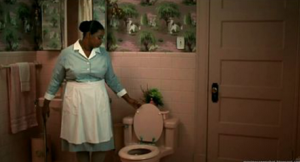
Another example of discrimination that is portrayed in the film is when Aibileen and Henry are riding the public bus home when the bus stops at a traffic block and the driver tells the “colored people” to get off the bus so that he can take the white people home (1:21:07). This scene contains numerous different forms of discrimination, from the fact that Aibileen and Henry were riding in the very back of the bus, entirely separate from the white people to the fact that they were forced to walk home. The filmmakers use a medium close-up on Aibileen and Henry before they are forced to get off the bus, to subtly show that they are in the very back of the bus, which is seen ever so slightly to the left of the camera’s focus. This technique enhances the portrayal of discrimination in the film because it adds another aspect of African Americans’ daily lifestyle that was affected by racism. This distinct illustration of racism also contributes to the film’s sole purpose, which is to show“the injustice of black-white race relations in the South at the dawn of the civil rights movement” (Rainer).
Even though the filmmakers of The Help carefully crafted the film in order to ensure that every detail was accurately portrayed regarding the real-life events during the civil rights movement, there was still a minute amount of criticism. Tiyi Morris, a professor of African American studies at Ohio State University, states that the filmmakers of movies, including those of The Help , “continue to ignore or deny the ugliness of racism and race relations throughout our nation’s history, instead opting for a sanitized and ultimately fictitious version of the past.” This was a common criticism of this film, due to the fact that it glazes over the harsh realities of racism and discrimination in the South, such as in lynching and violence. While this statement does contain some truth since The Help does not portray instances of the true violence that many black people faced during this time, there is valid reasoning as to why the filmmakers did not include such scenes. Since the film is rated PG-13, there are certain requirements that it must fulfill; if the movie were to portray the degree to which black people faced violence, the movie would need to be rated R. Also, the filmmakers made a decent effort in trying to depict the violence that African Americans faced, such as at 1:22:37 in the film, when Minny and Aibileen hear on the radio that a black man was killed by the KKK. Even though the film never shows the instance of the man being killed, the impact that it has on Minny and Aibileen shows enough. The filmmakers implicitly show their audience the violence that black people faced without graphically showing it on screen. So while criticisms of the movie state that the film shows a “fictitious version of the past,” others could counter the argument by showing scenes in the movie where the filmmakers allude to such violence black people faced amidst the civil rights movement (Morris).
The movie, The Help , portrays such a realistic and appalling version of the past that draws viewers in instantaneously. It is because of this reason that I decided to analyze this film. When I first watched The Help , I was astounded to see how white people treated such kind-hearted and hard-working African Americans. It truly broke my heart to see the amount of discrimination and power that white people had over innocent black people. I felt a deep connection to this movie in my heart because of the way that it portrayed white and black people. I found it interesting that while the white women were always trying so hard to look “perfect,” they often had more flaws than their maids. This shows the amount of humor that the filmmakers tried to include into The Help , they have a better interpretation of what it was truly like to be an African American in the 1960s. It is through films such as this that the issue of racial discrimination is brought to people’s attention in an urgent matter.
Due to the urgency of the issue regarding racial discrimination, it is important that people place themselves in the shoes of those who are part of racial minorities in order to understand the struggles that they have gone through. For example, imagining you were an African American maid in the South in the 1960s can directly show the treatment that black women received during this time period; not receiving appreciation, being paid incredibly low wages, not being able to use the restroom in the house, and raising another woman’s children as if they were their own are all hardships that these maids faced during this time. The movie, The Help , portrays the relationship between black maids and white women to show viewers how influential the civil rights movement was to today’s society; without the civil rights movement, society would not be as progressive as it is today, meaning that even more racial discrimination would exist than what already does. Overall, this film discusses such important topics regarding racial discrimination that everyone should watch it. If we want society to continue to progress towards racial equality, we must first become educated on what initially caused racial tension to understand the pain that many white people have caused other races.
Baek, Su Bin. “Minny Is Using the Guest’s Bathroom Not Maid’s Bathroom | © DreamWorks.” Medium.com,18 Dec. 2017, medium.com/@subinbaek/the-help-2011-you-is-kind-you-is-smart-you-is-important-5c04de42d28d.
Dargis, Manohla. “‘The Maids’ Now Have Their Say.” New York Times, 10 Aug. 2011, p. C1(L). Gale Academic OneFile, https://link.gale.com/apps/doc/A263841461/AONE?u=lbcc&sid=AONE&xid=2f46ca21. Accessed 16 Nov. 2020.
Davis, Sharen. “Skeeter Phelan (Emma Stone, Back to Camera) Plays Bridge with Friends Elizabeth Leefolt (Ahna OReilly, from Right), Hilly Holbrook (Bryce Dallas Howard and Jolene French (Anna Camp), While Aibileen Clark (Viola Davis) Looks On.” Latimesblogs.latimes.com,10 Aug. 2011, latimesblogs.latimes.com/alltherage/2011/08/sharen-davis-dressing-southern-belles-maid s-for-the-help.html.
Denby, David. “Maids of Honor.” The New Yorker, vol. 87, no. 24, 15 Aug. 2011, p. 96. Gale Academic OneFile, https://link.gale.com/apps/doc/A265027401/AONE?u=lbcc&sid=AONE&xid=31ab6a75. Accessed 16 Nov. 2020.
Miles, Carol. “The Help.” Journal of Religion and Film,vol. 15, no. 2, 2011. Gale Academic OneFile, https://link.gale.com/apps/doc/A271665744/AONE?u=lbcc&sid=AONE&xid=d95a6eda. Accessed 16 Nov. 2020.
Morris, Tiyi M. “(Un)Learning Hollywood’s Civil Rights Movement: a Scholar’s Critique.” Journal of African American Studies, vol. 22, no. 4, 2018, p. 407+. Gale Academic OneFile, https://link.gale.com/apps/doc/A573714537/AONE?u=lbcc&sid=AONE&xid=613252ff. Accessed 16 Nov. 2020.
Ndounou, Monica White. Shaping the future of African American film. Rutgers University Press, ebookcentral.proquest.com, https://ebookcentral.proquest.com/lib/linnbenton-ebooks/reader.action?docID=1687285. Accessed 17 11 2020.
Rainer, Peter. “The Help: Movie Review.” Christian Science Monitor, 9 Aug. 2011, p. N.PAG. EBSCOhost, search.ebscohost.com/login.aspx?direct=true&db=a9h&AN=63993388&site=ehost-live.
Robinette, Dale. “Heavy Handed Help Saved by Great Acting,” www.npr.org,2011, www.npr.org/2011/08/10/139086532/heavy-handed-help-saved-by-great-acting.
Difference, Power, and Discrimination in Film and Media: Student Essays Copyright © by Students at Linn-Benton Community College is licensed under a Creative Commons Attribution-NonCommercial 4.0 International License , except where otherwise noted.
Share This Book
Ohio State nav bar
The Ohio State University
- BuckeyeLink
- Find People
- Search Ohio State
Racism and Identity in Kathryn Stockett’s “The Help”
The Help is a novel by Kathryn Stockett that was published in 2009 and later turned into a film in 2011. Set in Jackson, Mississippi in the early stages of the Civil Rights Movement (1962-1964), The Help follows the story of three women (two black women, and one white woman) who come together to anonymously publish a book called The Help. The book that they write is comprised of stories about experiences of black women working as maids for white families in Jackson.
Due to the nature of the story and the time period that it is set in, it is easy to find examples of injustices, power struggles and questions of identity throughout the novel. Because it is set at the beginning of the Civil Rights Movements, race is a large theme throughout the novel. The author explores many false stereotypes about black people, including that they are dirty, lazy, unintelligent, and carry diseases. The depiction of race in the novel can be directly related to the concept of othering. The white people in Jackson are the “self” whereas the black people are the “other”. White people are contributing to the otherness of black people by believing stereotypes and treating black people as if they are worthless. For example, Minny, who is a black maid for a white woman, was unable to find a job because her former boss, Hilly, was telling everyone in town that she was a thief. In reality, Minny had not stolen anything, and Hilly was just mad at Minny for something else. Hilly completely ruined Minny’s chances of getting a job over a lie, and she did it just because Minny was black.
The Help also tackles the idea of identity in a couple of ways. The first way is through the story of Mae Belle. Mae Belle is white, and she is physically and verbally abused by her mother. Aibileen (who is black) is Mae Belle’s caretaker, and she makes sure to care for Mae Belle in a loving way and tells her often that she is loved and important. There was an incident at school in which Mae Belle drew a picture of herself and made her skin color dark like Aibileen’s. The book also follows the story of Lulabelle who looks white but comes from a black family. Both of these instances involve some sort of identity crisis. Mae Belle has only been shown love by a black person, so that seems to be how she identifies herself. She doesn’t understand why the white people around her have a problem about it. Lulabelle is stuck between two worlds. She isn’t “black enough” to be black, but she also isn’t “white enough” to be white. These situations have caused an identity crisis for both of these characters, which could negatively affect the way that they view themselves (and how others view them) for the rest of their lives.
Leave a Reply Cancel reply
Your email address will not be published. Required fields are marked *
Save my name, email, and website in this browser for the next time I comment.
- Share full article
Advertisement
Supported by
How ‘The Help’ Depicts Race Relations
To the Editor:
In “ Dangerous White Stereotypes ” (Op-Ed, Aug. 29), Patricia A. Turner argues that the white characters in the film “The Help” who supported racist practices were portrayed as “bad” people, which implied that “good” people were not racists. But in reality “that wasn’t the case,” she says; many of the supporters of racist practice were “white middle-class people, people whose company you would enjoy.”
Trying to understand racism by classifying people as good or bad is one of the oldest traps that conversations about race fall into. Being called a racist is a powerful attack that most Americans recoil from. And it stops further conversation that might help to resolve past wrongs.
Shouldn’t we use a film like “The Help” to talk about how racism can engulf an entire culture and ruin lives in the process?
Defining the problem as one of good and bad people only serves to create fissures that get in the way of talking about how racist practices harm us all. This is what “The Help” helps us to see. It is a far stronger statement against racism than many critics have acknowledged.
DAN ROMER Bryn Mawr, Pa., Aug. 30, 2011
The writer is a social psychologist who has studied racist practices and beliefs.
Prof. Patricia A. Turner makes an excellent point when she criticizes “The Help” for implying that good white people of the 1960s were by definition non-racist. But it does something even more insidious. It invites white audiences, as do most Hollywood movies about race, to identify with an enlightened white character — in this case, the stand-in for the author of the book, Kathryn Stockett.
In so doing, it validates our fantasy that we would have seen the truth and we would have risked our comfort for the sake of justice. It assures us that we would have been, and by extension we are now, on the side of right.
Funny how racism persists despite us white people being so darn virtuous!
MARY BROWN New York, Aug. 29, 2011
The writer is a director and producer of documentary films.
The median age of Americans is 37.2 years. So many viewers were not even born during the time depicted in “The Help”; hence, they have no idea what life was like in the Jim Crow-era South.
No one can argue that there wasn’t an oppressive political power imbalance, but not all whites were versions of Simon Legree (the cruel slave dealer in “Uncle Tom’s Cabin”) and not all blacks were the Rev. Dr. Martin Luther King Jr. or Rosa Parks.
In the black community we’ve had similar arguments before about “Roots” and “The Color Purple” that often ended in the following stalemate: The younger generation will not concede anything to the older because it doesn’t know what happened, and the older generation will not concede to the younger because it does know what happened.
DAVID L. EVANS
Cambridge, Mass., Aug. 29, 2011
Patricia A. Turner’s excellent essay confirms much of what I saw as a white girl growing up in Atlanta in the 1950s and ’60s. I, too, recall many estimable white people who harbored racist sentiments. I also know that there were at least two who vehemently opposed the racism that infected our world: my mother and father.
I remember boarding an Atlanta bus with my mother and finding no empty seats in the “whites only” section. This must have been before 1959, when Atlanta was forced to desegregate its buses. As dictated by local law, the most forward-sitting black person was required to vacate his seat so that my mother and I could sit. This would have meant dislodging an elderly black man with a cane.
My mother decided she wanted no part in supporting segregation. As he started to stand, she asked him please not to move, and sat me beside him.
Only as an adult did I understand how much courage it took for my mother to engage in this small act of civil disobedience.
It’s too bad that there weren’t more good white people who shared my parents’ convictions; it might have hastened the end of American apartheid.
MARIAN BASS Truro, Mass., Aug. 29, 2011
The situation portrayed in “The Help” didn’t exist only below the Mason-Dixon Line. Growing up in a 1960s liberal middle-class household on Long Island, my mother regularly referred to “the girl,” our 52-year-old housekeeper — and locked up the liquor when she came.
So, before we self-righteous Northerners point a finger at stereotyped Southern “white trash,” we should first look in the mirror.
PETER J. PITTS
New York, Aug. 29, 2011
As a Caucasian native of Jackson, Miss., where “The Help” is set, I devoured both the book and the film.
I disagree with Patricia A. Turner’s claim that segregation was “unquestioned” by whites. True, open opponents numbered few. But some whites kept their children in public schools after desegregation, despite peer ostracism. Catholic, Protestant and Jewish clergy formed an interracial Committee of Concern to rebuild black churches that were burned.
Jackson today, while imperfect, is transformed. The state’s history museum is honest. Brochures guide visitors to civil rights sites. And there’s Jackson-Evers International Airport, named for the civil rights activist Medgar Evers.
DWYN MOUNGER Knoxville, Tenn., Aug. 29, 2011
Colorblind Racism in “The Help” Film
Introduction, explicit racism and the pretense of colorblindness, celia: colorblindness and its attributes, eugenia: key issues.
Colorblind racism is relatively subtle and can be viewed as a modern-day type of racism that becomes especially widespread after its explicit, direct counterpart is eliminated (Thakore, 2014). Due to its subtlety, colorblind racism may be more difficult to pinpoint than the explicit one (McClure, 2015), but some of its primary frames have been found. In particular, they include “abstract liberalism,” “naturalization,” “cultural racism,” and “minimization” (Hughey, Embrick, & Doane, 2015, p. 1350).
In The Help , a film that is based on a novel of the same name, the society of Mississippi in the 1960s is rightfully described as explicitly racist, which appears to limit the application of the concept of colorblindness to the story. However, an analysis of the film demonstrates that the explicitly racist characters tend to employ some of the frames of colorblind racism to justify their ideas, and the few non-racist characters exhibit colorblindness or other patterns of racism. In other words, The Help can be employed to exemplify multiple patterns, including colorblindness, although not all of them are criticized in the work.
The majority of the characters in the film are explicitly racist. However, they employ some of the colorblind patterns to explain their behavior. For instance, Hilly insists that black people “carry different diseases than we do… I will do whatever it takes to protect our children” (Taylor, 2011). Thus, she suggests that racism can be explained by biological causes. This claim can be viewed as a form of naturalization, which is a type of colorblind racism that interprets racism as a natural occurrence that can be objectively rationalized by reasons other than race (Hughey et al., 2015). In fact, the film appears to suggest that Hilly, along with the majority of black and white characters of the town, normalize racism.
Indeed, Hilly proceeds with naturalization when she suggests that the black people enjoy segregation and supports this view by citing a personal opinion of a politician: “Separate but equal! That’s what Ross Barnett says, and you can’t argue with the governor” (Taylor, 2011).
Apart from demonstrating that racist worldviews are viewed as appropriate for a politician by the society that is described by the film, this phrase contains naturalization and, possibly, cultural racism, which is an attempt to explain racism with the help of cultural phenomena (Hughey et al., 2015). In particular, Hilly states that the existing situation should not be changed because is it socially and culturally appropriate and supported by the authorities.
Moreover, when refusing to lend Yule May money, Hilly states that “God does not give charity to those who are well and able. You need to come up with this money on your own” (Taylor, 2011). In this event, abstract liberalism is exemplified. Abstract liberalism uses some of the concepts of liberalism (for instance, equal opportunity) without taking into account the circumstances that affect different groups. In the film, it is obvious that the discrepancies in the wealth between Hilly and Yule May are explained by racism, but Hilly denies the economic consequences of discrimination, illustrating abstract liberalism.
Finally, Hilly minimizes racism by suggesting that she is not racist: “Believe it or not, there are real racists in this town” (Taylor, 2011). Minimization is another approach to colorblindness that attempts to downplay the cases of racism (Hughey et al., 2015). Racism is visible in Hilly’s behavior and can be exemplified by her previous quotes, which is why it is evident that her statement is an attempt at minimization.
Some of the other characters also seem to employ some of the colorblindness frames. For example, when discussing the event that resulted in firing Constantine, Charlotte states: “She didn’t give me a choice.” Given the specifics of the event itself (Constantine’s daughter using the front door rather than the back one), it is apparent that Charlotte attempts to downplay racism-related issues (minimization). Moreover, she naturalizes this event by refusing to acknowledge that it is discriminatory. Finally, the situation appears to be framed predominantly by customs and etiquette, which can be viewed as cultural phenomena; therefore, Charlotte’s example illustrates cultural racism as well. Thus, all the frames of colorblindness can be exemplified by the words and actions of the racist characters of the film.
Non-racist characters include Celia and, apparently, her husband. Celia is explicitly colorblind (for example, she refuses to eat separately from Minny), and her husband seems to share her perspective. Their acceptance results in Minny’s continued and stable employment, which helps Minny to leave her abusive husband. In general, the relationships between the three characters seem to be mutually supportive.
However, the colorblindness exhibited by the wealthy white couple has its typical drawbacks. The problem of racism is never explicitly criticized in the household; rather, it is ignored. It can be suggested that some implicit criticism is present in the refusal of the couple to mistreat Minny, but this criticism is limited to interpersonal relationships. The institutional racism or its economic consequences are not discussed. At the same time, the consequences are illustrated by the power dynamics of a wealthy white couple and their poor black servant.
The final scene that features all the three characters intends to demonstrate the colorblindness of the couple by showing that Celia serves Minny food prepared by Celia. However, this event is unlikely to be repeated: the couple states that they want to proceed to employ Minny. Therefore, the action shows support and gratitude, but it is unlikely to change the dynamics between the characters, the reasons of which are related to the color-based discrimination that the couple chooses to ignore by being blind to it.
Due to their colorblindness, the couple’s behavior can serve as an example of abstract economic liberalism with elements of normalization and, possibly, cultural racism. In particular, Celia and her husband ignore the causes of the economic inequality exemplified by the dynamics between them and Minny, normalizing these issues as culturally and socially appropriate. In other words, the couple’s colorblindness has the typical drawbacks of the phenomenon (Hughey et al., 2015). However, the film does not explore this problem, focusing on the less subtle forms of racism.
Eugenia is another non-racist character. She is opposed to the racism of her peers and provides black women with an opportunity to voice their discontent. Eugenia is hardly colorblind because the environment does not provide her with a chance to disregard racism. She also does not criticize colorblindness because she is focused on explicit racism and, possibly, does not face colorblindness during the events of the movie. The only types of colorblindness that she encounters are the colorblind-like excuses provided by explicitly racist characters, which makes them easy to criticize. However, there are racism-related issues that are connected to Eugenia.
First, Eugenia is attracted to the “mammy” archetype. Initially, “mammy” may appear as a positive characteristic: a “mammy” is described as a motherly figure that is loyal, loving, cheerful, and religious. Naturally, like any stereotype, “mammy” is harmful because of its overgeneralization, which depersonalizes the women described by this word, affects judgments and behaviors directed at them, and upholds discriminatory practices and patterns (Rosenthal & Lobel, 2016). However, the primary issue of the archetype is the fact that the motherly love and loyalty of “mammies” is supposed to be directed towards white people and their children (Thompson, 2014). In other words, “mammy” is the direct outcome of inequality and discrimination.
In fact, Eugenia highlights the issues experienced by “mammies” during the first moments of the film, asking “What does it feel like to raise a white child when your own child’s at home being looked after by somebody else?” (Taylor, 2011).
This question and Aibileen’s answer imply that Eugenia realizes the issues that are related to the “mammy” role, but she romanticizes it instead of criticizing it along with the racism patterns that result in it. Thompson (2014) demonstrates that such attitudes are likely to perpetuate the stereotype, which is why Eugenia’s romantic understanding of the “mammy” archetype can be viewed as racial stereotyping (McClure, 2015). Thus, the non-racist protagonist of the movie has adopted at least one racist pattern.
Another problem in Eugenia’s actions is the way she treats Aibileen when recruiting her. In the film, Eugenia is tasked with writing a newspaper column devoted to housework, and she asks Aibileen to provide consultations. However, to do so, she inquires Aibileen’s employer (Elizabeth) if Aibileen can spare the time to help. In the film, Eugenia does not ask Aibileen or provide her with any compensation for this work (she only sends Aibileen a reward for her contribution to the book).
Therefore, she uses Aibileen’s resources (time and effort) without permission or compensation, which could be interpreted as a form of normalization or cultural racism. Apparently, such attitudes towards the resources of black women are viewed as socially and culturally acceptable, and they benefit Eugenia, which is why she acts accordingly. Thus, even the supposedly non-racist characters of the movie exhibit racist behaviors.
In summary, the film includes multiple mimics of all the four frames of colorblindness presented by racist characters in an attempt to justify their worldview as well as actual colorblindness exhibited by the characters who neglect institutional racism. Moreover, the film includes racial stereotyping along with the appropriation of a black woman’s resources performed by the white protagonist. The above-presented analysis framed these patterns of racism, demonstrating the possible use of colorblindness and some other terms.
It can be concluded that the film incorporates a variety of racism patterns, some of which are explicit and become criticized while others might be unintentional and go unexamined. This feature seems to mirror the reality of racism, which is similarly complex. Moreover, the analysis reveals the use of colorblind patterns by explicitly racist characters. Since colorblindness is typically described as a subtle form of racism, the examples demonstrate that the differences between it and explicit racism may be not very extensive.
The film predominantly focuses on the direct forms of racism and shows their detrimental nature. However, the application of colorblind frames and other terminology indicates that less explicit and more subtle patterns also contribute to the perpetuation of racism and hinder its analysis or criticism by disregarding it. The fact that subtle racist patterns go unexamined by the film mimics their neglect in the real world, and the analysis demonstrates the significance of paying attention to them in order to progress towards inclusive multiracial democracy.
Hughey, M., Embrick, D., & Doane, A. (2015). Paving the way for future race research . American Behavioral Scientist , 59 (11), 1347-1357.
McClure, S. M. (2015). Getting real about race: Hoodies, mascots, model minorities, and other conversations. Thousand Oaks, CA: Sage Publications.
Rosenthal, L., & Lobel, M. (2016). Stereotypes of black American women related to sexuality and motherhood . Psychology of Women Quarterly , 40 (3), 414-427.
Taylor, T. (Director). (2011). The help . Web.
Thakore, B. (2014). Maintaining the mechanisms of colorblind racism in the twenty-first century . Humanity & Society , 38 (1), 3-6.
Thompson, K. D. (2014). Taking care a white babies, that’s what i do. In C.O. Garcia, V.A. Young, & C. Pimentel (Eds.), From Uncle Tom’s Cabin to The Help (pp. 57-72). New York, NY: Palgrave Macmillan US.
Cite this paper
- Chicago (N-B)
- Chicago (A-D)
StudyCorgi. (2021, January 15). Colorblind Racism in “The Help” Film. https://studycorgi.com/colorblind-racism-in-the-help-film/
"Colorblind Racism in “The Help” Film." StudyCorgi , 15 Jan. 2021, studycorgi.com/colorblind-racism-in-the-help-film/.
StudyCorgi . (2021) 'Colorblind Racism in “The Help” Film'. 15 January.
1. StudyCorgi . "Colorblind Racism in “The Help” Film." January 15, 2021. https://studycorgi.com/colorblind-racism-in-the-help-film/.
Bibliography
StudyCorgi . "Colorblind Racism in “The Help” Film." January 15, 2021. https://studycorgi.com/colorblind-racism-in-the-help-film/.
StudyCorgi . 2021. "Colorblind Racism in “The Help” Film." January 15, 2021. https://studycorgi.com/colorblind-racism-in-the-help-film/.
This paper, “Colorblind Racism in “The Help” Film”, was written and voluntary submitted to our free essay database by a straight-A student. Please ensure you properly reference the paper if you're using it to write your assignment.
Before publication, the StudyCorgi editorial team proofread and checked the paper to make sure it meets the highest standards in terms of grammar, punctuation, style, fact accuracy, copyright issues, and inclusive language. Last updated: October 18, 2022 .
If you are the author of this paper and no longer wish to have it published on StudyCorgi, request the removal . Please use the “ Donate your paper ” form to submit an essay.

Kathryn Stockett
Ask litcharts ai: the answer to your questions.
At its core, The Help is an exploration of the ways in which racism pervaded every aspect of social life in 1960s Jackson, Mississippi – from Jim Crow laws that sanctioned discrimination and segregation as official policy to casual conversations between middle-class white women. In particular, the novel focuses on how white housewives justified the exploitation and emotional abuse of their black maids by convincing themselves that black people are fundamentally different from – and…
Gender and the Home
Focused as it is on female characters—white and black— The Help portrays how the home, a traditionally feminine space, was just as much a battleground for social change as were the courtrooms and rallies of the 1960s Civil Rights Movement. While Aibileen describes how white men beat or kill black men who “stepped out of line,” the novel also shows how white women used their social influence to ruin the lives of the black maids…
Social Class
The Help offers an in-depth meditation on the complicated effects that class has on people’s social interactions, specifically with regards to race. The Help portrays class as providing the basis for Jackson’s tiered white society: the wealthy and “well-bred” are at the top, setting the social conventions and attitudes for everyone else below. Elizabeth Leefolt and Celia Foote exemplify opposing ways of how a white Southern woman can navigate social class. Elizabeth comes from a…
Help vs. Hypocrisy
“Help” normally signifies the giving of free services or resources to those in need, but the novel’s title refers directly to the underpaid black domestic workers who, paradoxically, are the ones “helping” their wealthier and more powerful employers, people who have no real need of help. By referring to these women as “the help,” the white housewives uphold the illusion that the maids are like volunteers who want —or should be grateful for the opportunity—to…
Writing, Storytelling, and Freedom
The theme of writing is threaded throughout The Help, as the novel melds fact and fiction to showcase the power of storytelling. In an act of defiance against the gender norms of her time, Miss Skeeter seeks self-determination through the act of writing. As a white woman in her society, she would have been expected to maintain the social order, to not “stir up trouble.” Skeeter’s book allows her to pit herself against not only…
by Kathryn Stockett
The help essay questions.
The Help is very critical of the organized racial segregation of the 1960s, but some people have alleged that this novel perpetuates a subtler version of racism. They argue that the novel highlights the ungrammatical speech of the black maids, and makes their story secondary to that of a white woman (Skeeter). Do you think this claim has merit? Why or why not?
I think this claim does have merit. At the end of the novel, Skeeter lands a prestigious job in New York City on the basis of the book she wrote about the maids, but the maids themselves find their circumstances unchanged. Minny's husband has been fired from his job on the basis of her work on the book, and she must leave her family before her husband kills her. Aibileen is fired from her job with the Leefolts due to Hilly's interference. Skeeter and the maids did not benefit equally from the publication of the book. In the same way, the author Kathryn Stockett may have benefited financially and professionally from exploiting the stories of the maids in her own life.
The novel takes place nearly a century after the end of slavery, yet many of the black characters in the book still work extremely demanding and unpleasant jobs. What factors (social, economic, educational, etc.) keep them in these sorts of positions?
Aibileen mentions that her mother was a maid and her grandmother was a house-slave. She also says that her mother pulled her out of school in order for her to start work as a maid, because she needed to support the family. Aibileen's parents were not paid a great deal for their work (perhaps because they are black), so their daughter must leave her education in order to contribute to the family. Without education, she cannot move to another job. Additionally, if Aibileen tried to leave her job as a maid for another position, she might be subject to harassment for being "uppity"; we see evidence of this in Hilly's treatment of Yule May, who is one of the most educated maids in Jackson.
The novel depicts very warm relationships between black maids and the white children they care for - Aibileen and Mae Mobley, Constantine and Skeeter. However, these relationships are also marred by racial and economic inequality. Can there be genuine affection in such a complicated and unequal relationship? Can you compare the relationships depicted in this book with your own experiences of caregiving?
I think there can be genuine affection in such a complicated and unequal relationship. After all, an adult must have some tender feelings for the child, or else he or she would just quit the job. Aibileen mentions that she has become a specialist at raising children, which shows that she chooses this line of work because she likes it. Her relationship with Mae Mobley is similar to my experiences babysitting for a local family. Some people might think that just because I was being paid for this work means that I didn't really care for the child, but in fact I worked even harder at this job because I cared so much for the child.
Why does Skeeter give Stuart a second chance after their first date was so disastrous? Do you think this was her own choice, or was she pressured to do this? Would you have made the same choice that she did?
I think Skeeter was under some pressure from her mother, Hilly, and society to give Stuart a second chance. Skeeter's mother was constantly asking why she did not have a steady boyfriend, and Hilly wanted Skeeter to date Stuart in order to further her own husband's political career. Skeeter was also the only one in her friend group who was not yet married, so she was probably more likely to give Stuart a second chance than another woman in a similar situation. I would not have made the same choice as Skeeter, because I believe that Stuart ruined his first impression by being drunk and rude during their first date. Behaving in such a way during a first meeting is not a sign of good things to come.
The Help is often praised for its well-rounded, complex characters. How does the author create such characters, and what sorts of literary strategies does she use? Focus your analysis on one character.
I will look at the character of Minny. To create a unique voice for Minny, the author uses a form of African-American vernacular when writing from her perspective, which differentiates her from Skeeter and other white characters. Unlike the other narrators, Minny frequently makes sarcastic and funny remarks. For example, when she gets the job with Celia, she notes, "Relief hits me. [...] I don't have to move to the North Pole. Won't Santy Claus be disappointed" (pg. 45). Minny is also very reluctant to bring up aspects of her personal life; it is very late in the book when she mentions how violently her husband acts towards her. This gives the reader the impression of a person who likes to keep certain things to herself.
Chapter 25 is the only chapter in the book that is written in the third person. Why do you think the author chose to do this? What does it accomplish? Does this chapter have a different tone than the other chapters?
I think the author chose to do this in order to show the scene from a neutral perspective. If she wrote it from the point of view of one of the narrators, that narrator would add her own opinions and perspective to it. For example, if Aibileen or Minny wrote it, they would focus on the catering work they were doing rather than on the events unfolding. Likewise, if Skeeter narrated it, she might hone in on the exclusion she felt from the other members of the League, and may not have paid much attention to what was happening with Celia.
Many of the main characters in The Help are social outsiders; for example, Skeeter is considered something of a misfit for being more interested in writing than boys. However, in other places and times such behavior would be considered normal. How much of a person's character is shaped by the time period in which he or she lives?
I think a great deal of a person's character is shaped by the time that she or he lives it. It is possible that some personality traits are inherent and would hold true anywhere, but those traits will be perceived differently in various societies. For example, Minny's sharp tongue might have made her a famous comedian if she had been born today; but in 1960s Jackson, her acerbic wit is just a liability. The cold reception she receives makes her more bitter and angry, which in turn makes her say harsher things.
Choose one historical event mentioned in the novel (The assassination of Medgar Evers, the march on Washington, the invention of the birth control pill, the war in Vietnam, etc.) and research it. What was the impact of this event on society at the time? How did people react to it? How do the reactions of the characters in The Help compare to the reactions of real people?
The invention of the birth control pill was hailed as a revolution for many women, despite the fact that it was initially prescribed only for married women. Like many people, Skeeter marveled at this incredible new technological development. There were a number of religiously based objections to this medicine when it was introduced, but this historic development is not reflected in The Help . Minny does not make mention of the birth control pill, but it could have changed her life by allowing her to limit the size of her family.
There are many instances of revenge in the book - Skeeter's prank with the toilets, Hilly's imprisonment of Yule May, Minny's "Terrible Awful," the way Hilly ostracizes Celia. Which is one example of revenge that goes too far, and what is one example of revenge that you think is justified? Why?
I think that the bid that Miss Walters placed on the pie at the Benefit is an example of revenge that is justified. By placing the bid, she reminded her daughter of the "Terrible Awful," but did so in a way that would not be apparent to anyone who did not know the story. Miss Walters was angry with her daughter for placing her in a retirement home, and this was a clever way to remind her that Miss Walters knew her darkest secret. One example of revenge that went too far was Skeeter's prank with the toilets on Hilly's lawn. Though this was a humorous scene, Skeeter should have known that it would have major consequences.
The women of The Help deal with a variety of problems related to sex/gender and sexism, but their experiences differ due to race, class, and age. Choose two characters from the novel and compare the types of sexism that they struggle with.
Skeeter struggles with demands that she marry and give up her professional ambitions. She wants to keep working, but her family and her friends would rather she settle down. On the other hand, Minny was married at a young age and is forced to continue working as a maid to support her family; unlike Skeeter, Minny does not struggle to work outside of the home.

The Help Questions and Answers
The Question and Answer section for The Help is a great resource to ask questions, find answers, and discuss the novel.
What Page number is this quote on?
Page numbers differ depending on the copy you have.
What is the conclution of the drama?
In the final chapter, all three of the main characters (Skeeter, Minny, and Aibileen) are poised on the edge of a great change in their lives. Skeeter's new beginning is a bit more promising than that of the others; though she cannot publicly...
What role does mothers and daughters play in the play?
Mothers and daughters have difficult but deeply loving relationships. The Help examines several different types of mother-daughter relationships.
Elizabeth Leefolt has a strained relationship with her mother, who is aloof and demanding; she...
Study Guide for The Help
The Help study guide contains a biography of Kathryn Stockett, literature essays, quiz questions, major themes, characters, and a full summary and analysis.
- About The Help
- The Help Summary
- Character List
Essays for The Help
The Help essays are academic essays for citation. These papers were written primarily by students and provide critical analysis of The Help by Kathryn Stockett.
- Devastation Through Segregation
- Internalized language stereotypes within The Help
- The Problem of Female Identity: Restrictive Gender Constructs in 'The Help' and in Plath's Poetry
- Trauma and Racism: 'The Help' as Understood in Print, in Film, and in Scholarly Sources
- Challenging Behaviors and the Audience
Lesson Plan for The Help
- About the Author
- Study Objectives
- Common Core Standards
- Introduction to The Help
- Relationship to Other Books
- Bringing in Technology
- Notes to the Teacher
- Related Links
- The Help Bibliography
Wikipedia Entries for The Help
- Introduction
- Plot summary
- Film adaptation
- Awards and honors
Home — Essay Samples — Literature — Book Review — Racism And Segregation In The Help
Racism and Segregation in The Help
- Categories: Book Review Segregation
About this sample

Words: 554 |
Published: Nov 8, 2019
Words: 554 | Page: 1 | 3 min read

Cite this Essay
Let us write you an essay from scratch
- 450+ experts on 30 subjects ready to help
- Custom essay delivered in as few as 3 hours
Get high-quality help

Prof. Kifaru
Verified writer
- Expert in: Literature Social Issues

+ 120 experts online
By clicking “Check Writers’ Offers”, you agree to our terms of service and privacy policy . We’ll occasionally send you promo and account related email
No need to pay just yet!
Related Essays
2 pages / 927 words
3 pages / 1209 words
3 pages / 1481 words
2.5 pages / 1232 words
Remember! This is just a sample.
You can get your custom paper by one of our expert writers.
121 writers online
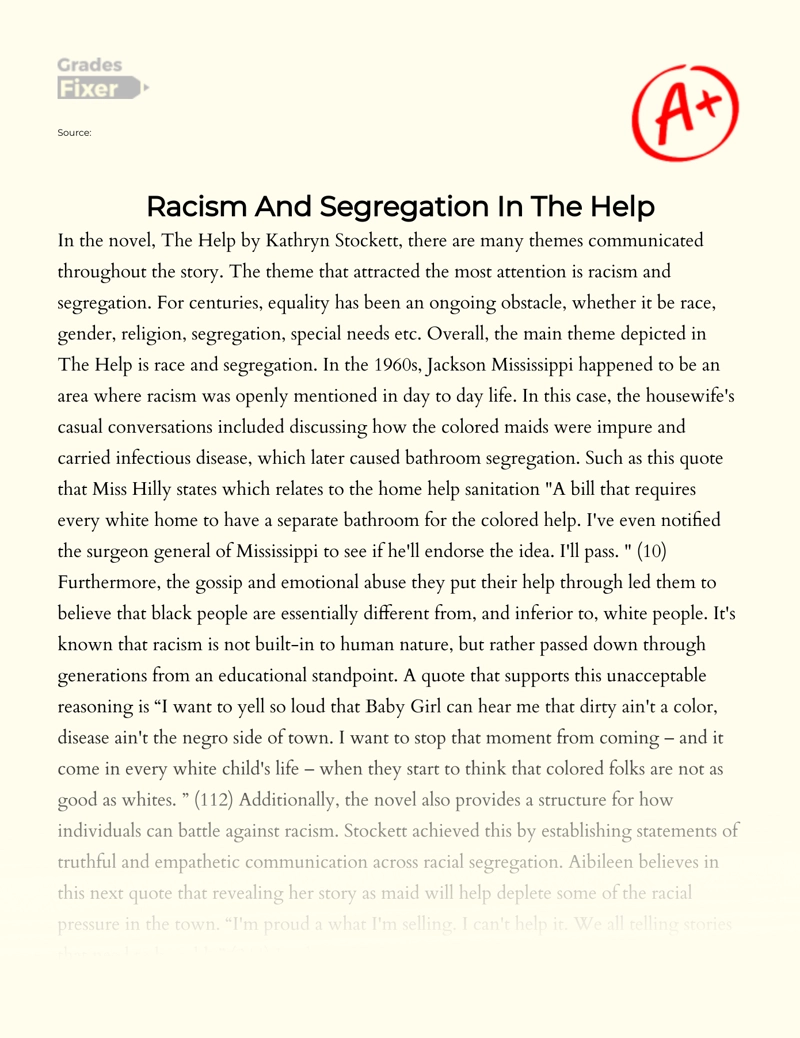
Still can’t find what you need?
Browse our vast selection of original essay samples, each expertly formatted and styled
Related Essays on Book Review
In the realm of short stories, "What of This Goldfish, Would You Wish?" by Etgar Keret stands as a captivating narrative that delves into themes of greed, human connection, unintended consequences, and more. Through the tale of [...]
In the text “This is Water” by David Foster Wallace although many people may seem to the center of the universe, Wallace guides them to be aware of the world around them. Wallace uses emotional and logical appeals in his main [...]
The Life of Pi is a story about survival, and how a belief in God can make a boy into a man and how facing life and death in the Pacific Ocean can lead to either utter despair or having an unwavering faith in God that can lead [...]
I’ve read quite a few books in my lifetime. There were a few I’ve loved, there were even a few I’ve absolutely hated. I can honestly say I’ve read more books that I hated than I actually write, mostly because reading just isn’t [...]
Exploring Memory as a Theme: Discuss how the theme of memory is explored in "Cherry Bomb" by Maxine Clair, considering its significance in the narrative and the characters' lives. Memory and Identity: [...]
T. S. Eliot’s The Love Song of J. Alfred Prufrock demonstrates several Modernist ideas. In particular, by frequently employing imagery, repetition, alliteration, assonance, rhetorical questions and references, creatively shaping [...]
Related Topics
By clicking “Send”, you agree to our Terms of service and Privacy statement . We will occasionally send you account related emails.
Where do you want us to send this sample?
By clicking “Continue”, you agree to our terms of service and privacy policy.
Be careful. This essay is not unique
This essay was donated by a student and is likely to have been used and submitted before
Download this Sample
Free samples may contain mistakes and not unique parts
Sorry, we could not paraphrase this essay. Our professional writers can rewrite it and get you a unique paper.
Please check your inbox.
We can write you a custom essay that will follow your exact instructions and meet the deadlines. Let's fix your grades together!
Get Your Personalized Essay in 3 Hours or Less!
We use cookies to personalyze your web-site experience. By continuing we’ll assume you board with our cookie policy .
- Instructions Followed To The Letter
- Deadlines Met At Every Stage
- Unique And Plagiarism Free
‘The Help’ Isn’t Racist. Its Critics Are.
In the week since its release, The Help , a movie telling the story of a group of black maids in the South in the early 1960s, has been derided repeatedly in blog posts and reviews as a lazy collection of racist tropes, an irredeemable expression of naive bigotry. In an article in the New York Times , film critic Nelson George condemns the filmmakers for failing to properly “come to terms” with America’s racist past. In her review, the University of Georgia’s Valerie Boyd simply called The Help “a feel-good movie for a cowardly nation.”
But I suspect more than a few Americans—many of them black—are coming out of The Help asking their companions “Um, was that movie really racist?” The answer, simply, is no—and the absence of bigotry in the film ought to be apparent to anyone watching it with an open mind. Unfortunately, many people obviously aren’t.
But the ubiquity of the insults against The Help , despite its evident lack of racism, is itself instructive. All too often, charges of racism are the products not of reasoned analysis, but cognitive dissonance: an implacable pique at white America for never quite “owning” its racism, despite a lack of clarity as to just what this owning would entail.
It is a frame of mind that is the product of one of the glummest detours in black history. Just when the Civil Rights Act and Voting Rights Acts gave thoughtful black people the grounds for a truly autonomous and positive racial self-image, identity politics and the hard-left turn in the world of letters taught instead that that there was a higher wisdom in hearkening ever back to despair. The second shoe having yet to drop, many blacks have been left with a self-conception that is perpetually incomplete—they are ever-questing, ever-owed, never truly whole. Told they were nothing for centuries, many black people are choosing to keep that legacy alive by assailing the depredations of an abstract and evil other, rather than adopt a more self-directed and positive self-image.
In media criticism, this world view manifests itself in the pedantic dismissal of nearly all commercially viable depictions of black people as stereotypes, insults, and other evasions of that eternally withheld “acknowledgment” of racism. Though it is presented as a form of pride, this studiously joyless way of taking in films and television is actually a lack of self-sufficiency and independence of mind. In that way, black pundits’ reflexively hostile take on The Help is a more articulate testament to the depredations of racism than anything in the movie itself.
LET’S REVIEW THE PLOT of this supposedly so benighted piece of work. Emma Stone’s Skeeter, fresh from college and seeking a writing career in contrast to her housewife friends, compiles an oral history book from her Mississippi town’s black maids, starting with one friend’s maid Aibileen (Viola Davis). Despite her employer’s pitiless treatment, including restricting her to a separate bathroom, Aibileen comes along only reluctantly, scarred by her son’s death from racist neglect after an accident and memories of violence inflicted after black people she knows even tried to vote. Even her fiery-tempered friend Minny comes along only with trepidation, meanwhile getting fired from her job for an especially colorful act of insubordination. Local NAACP field secretary Medgar Evers’ assassination, and a more local injustice sparked by Hilly Holbrook, an especially bigoted queen-bee friend of Skeeter’s, spur 31 more maids to come forward for the book. It’s a hit. It gets Skeeter a New York writing job she reluctantly leaves home to take, but leaves Aibileen jobless for contributing to it. Walking away from the employer’s house for the last time, she feels a certain freedom, but she has no job, and also despairs at abruptly leaving the white child who thought of her as her real mother.
This is a “feel-good movie for a cowardly nation”? How could it be that this film, hardly The Sorrow and the Pity but honest and thoroughly affecting, is being treated like a remake of Imitation of Life ?
We must dismiss out of hand a discomfort with this sad period being “packaged” by Hollywood at all. The Help certainly includes swelling strings on the soundtrack, what Nelson George terms its “candy-coated cinematography,” and neatly intertwining stories with beginnings, middles, and ends. Some might prefer a visually peculiar, spiritually ambiguous, narratively desultory art-house opus. But that film would be seen by only a few, which would contravene the imperative that America as a whole needs to see it to learn about its racist past.
Consider for a moment the opposite case: Say that Hollywood, with its fundamentally commercial orientation, decided not to touch topics as sensitive as the Civil Rights story. The very same critics would no doubt despair that, “Hollywood doesn’t want to address America’s racist past.” The critics who inveigh against The Help for its mass market appeal are being duplicitous. Long ago, black film and television historian Donald Bogle counseled that “black films can liberate audiences from illusions, black and white, and in so freeing can give all of us vision and truth.” That’s a very debatable proposition—but, in any case, it would require that this “responsibility” be exercised within realistic commercial parameters. To be liberated, the audience has to show up.
Within these commercial bounds, then, a major beef of the critics is that the film fails to, as Nelson George judges the issue, “come to terms” with America’s racist past. George dislikes that the film treats Medgar Evers’ murder as a background occurrence, impatient with the story’s dwelling on kitchens and living rooms. But writers have used interpersonal interactions to bring historical periods alive for a very long time now: Is George opposed to the genre of historical fiction? Surely not—but apparently the Civil Rights movement is an exception, incommensurate somehow with the “responsibility” Bogle referred to, perhaps.
But even here, would George allow even an Evers-centered version of The Help as having finally “come to terms” with racism, given that in his article he even feels that Spike Lee’s Malcolm X fell short of the task? And what, exactly, do we mean by “coming to terms”? We must know, if these critics’ complaints are to qualify as constructive counsel. The difficulty of conceiving an answer is indicative. It is not unreasonable to wonder if there is a plausible development in film that could ever qualify as having done the deed. Is complaint the goal itself?
Or take Valerie Boyd’s objection that “The movie never links [Evers’] assassins’ behavior to the relatively benign, comedic behavior of Hilly and her ilk.” Again, in terms of how a film is written and performed, just how would this “linking” be done effectively? Is a character supposed to give a speech about the nature of institutional racism, only to look like a pasted-in mouthpiece? “Coming to terms with racism” is today an almost musical phraseology in the guise of concrete suggestion, along the lines of claims that there is a “conversation” of unspecified format on race that America “never has,” as Attorney General Eric Holder referred to in 2009 and Boyd, predictably, references.
THAT THESE WRITERS are driven more by a frozen animus than a response to the film itself is especially clear in that they miss so much in the narrative that contradicts their analysis. George asks of films about black history, “Do the filmmakers put us inside the head of the black woman braving a gantlet of cheering whites to integrate a segregated school?” and proposes that “It is this nuanced humanity that this movement demands.”
Nuance, we suppose, such as when Aibileen, soberly describing what it’s like to raise other people’s children while your own are at home—or dead—recounts to Skeeter how another white toddler she all but raised asked why she was black and Aibileen jokingly said it was because she had drunk too much coffee. Davis imitates the toddler’s facial expression and drifts into laughter through near tears. It’s a heartbreaking passage, worthy of an Oscar alone. No “nuance” here?
“The sense of physical danger that hovered over the Civil Rights movement is largely absent,” George decides—of a film in which the police crack one maid over the head with a club so soundly that the audience I saw it with winced, and other black women make assorted references to beatings and burnings that have scared them into submission? The Help denies “the casual, commonplace quality of racial prejudice” in favor of cartoons, George says, about a film that includes a bus driver casually saying “a nigger got shot” to black riders, plus the scenes involving the separate toilets, and much else.
Boyd, meanwhile, misses that Abileen is paid for the book along with Skeeter; that, while Skeeter does not stand up and make a speech about the evils of bigotry, she is so disgusted with Hilly’s racism that the two are no longer friends by the middle of the film, at which point Skeeter embarrasses her publicly; and that the maids do not “inexplicably” consent to be interviewed about the hardships of their lives—they do so slowly and reluctantly, and always fearing for their lives.
One senses that for many, the sheer fact that the movie is about black maids prepared them to sharpen their pencils to decry dusted off Queenies and Beulahs, with the actual content of the movie of little interest. “ The Help ’s representation of these women is a disappointing resurrection of Mammy,” the Association of Black Women Historians complains, a judgment hard to imagine from people who have actually seen both The Help and Gone With the Wind .
CRITICS ALSO SEEM UNCOMFORTABLE with the fact that the film includes comedy. Non-black critics, too, are regularly exhibiting the same supposedly wise skepticism of such “hijinks;” the New York Times’ Manohla Dargis considers the occasional comedy scenes trivializing , as if in the old South blacks and whites spending most of their waking lives with one another interacted solely in chilly, guarded fashion. We like to imagine it that way, as it comforts us that we are aware of the injustice of racism. But to dismiss about ten total minutes of edgy antics involving Minny and about five more involving commodes and bad hair days as rendering the whole movie “about ironing out differences and letting go of the past and anger” is, ironically, a dehumanization of the black experience.
We dishonor black people of the past in assuming that they spent their entire lives fuming at the white man and suffering his abuse. As human beings with a survival instinct, they carved meaningful existences out of what they had been given. This included laughing and good times and, yes, some of it was between whites and blacks.
Laughing, good times, and love, too. The titillation aspect assures that we are regularly taught about the carnal part—Sally Hemmings and such. But maids who raise people’s children have always come to love them, and even Jim Crow could not stanch this fundamental aspect of human nature. It was once common in South Carolina and Georgia for white children to grow up speaking the maids’ “Geechee” dialect, so close was this kind of bond. Aibileen’s love for a little white girl seems to especially get under many critics’ skin: “The kind of ambiguity and complexity that a woman like Aibileen would have felt for that white child is too much for the filmmakers to handle,” Boyd complains. But it could be that it’s Boyd who doesn’t want to handle that a black maid could hate the racism of her society and yet love an innocent white child she spends six days a week one on one.
AT THE END of the day, it is hard to see what The Help ’s creators could have done that would have passed muster. Those ever seeking for Hollywood to “come to terms” with black people have developed such an imposing battery of objection tropes over the past forty years that I suspect they would reject even Raisin in the Sun as a bag of stereotypes if it were new.
The Association of Black Women Historians, for example, has distributed a statement condemning the film for, among other things, not depicting white men sexually harassing their maids. But then if The Help had, say, Dennis Quaid as a white husband violating Aibileen, while later Minny’s daughter, starting out as a maid, underwent the same from, oh, let’s say Matthew McConnaughey, wouldn’t we be hearing that The Help is one more film soft-pedaling the strength of black women working hard to support their families, and instead depicting black women as vehicles for white male lust? That was the word on the street, recall, about Monster’s Ball with Halle Berry and Billy Bob Thornton. Or, if Aibileen were shown writing the book herself, which various critics would prefer, wouldn’t it be time to gripe that it sugarcoated the remorseless limitations on advancement for poorly educated black women of the period?
Let’s try a version of The Help that might pass muster with its current critics. The maids would hold the white children at a polite arm’s length. Evers’ murder would be the dramatic focus. The white men behind it would be the main characters, while the maids’ women employers would be background figures. Also, to assuage a common strain in the criticisms, an obscure, very humble working-class black maid of modest education in 1963 would sense it plausible to pen a protest manuscript herself and send it to publishers, rather than rely on Skeeter to do the writing and submission.
To wit: The film that The Help should have been would be psychologically implausible, dramatically reductive, preachy, and not The Help at all. I cannot accept that this would be preferable for any reason to the solid, affecting Hollywood drama that I took in.
Of course, putting this burden on The Help might make a kind of sense if American society were actually as resistant to acknowledging racism as we are so often told. One might see the film as a precious opportunity to introduce a forgotten story, and understandably wince to see the focus on living rooms rather than streets, women in the afternoon rather than Klansmen at night, and sprinklings of harmony in a story that should be about gunshots and fire hoses.
But blissfully, time did not stop in 1963. Historians black and white churn out books and films on racism year round. There will soon be a black history museum in Washington, DC. There is a Black History Month. Mainstream media organs are assiduously devoted to coverage of the black experience: The New York Times is even disproportionately committed to covering white yuppies moving into poor black neighborhoods over countless other ethnic moving trends. Colleges and universities regularly have black studies programs and departments. Stories about racism against black people are prime fodder for the media. Socially, being accused of racism is almost as feared as being accused of pedophilia. Recently, for a while there were three Broadway productions exploring racism, past and present, running at the same time: Race , Memphis and The Scottsboro Boys . The first two were hits. The third was brought to the Great White Way despite not having been a hit Off-Broadway, and by white producers. All three will have long lives in productions around the country.
Post-racial America is not, but is this an America in denial about racism? Yet The Help ’s critics seek a relentlessly glum, purse-lipped threnody of a film—perhaps shot in black and white?—monotonously instructing America in its moral inadequacy. Yet if Hollywood did produce a string of race-related narratives that 1) did not “feel good” 2) were judged as “coming to terms with racism” by our critics and 3) were somehow seen by more than seven people, the new word on the street would be that America’d better not think it’s off the hook just because of a few movies. This is not intellection; it is recreation.
More than a few black Americans harbor scars from the contemptuous treatment their grandparents endured from the likes of Hilly Holbrook. This is why it is perceptible that these critics are seeking The Help to heal not America, or black people in general, but themselves.
The Help ’s director and producer Tate Taylor, white, grew up with a black maid . She’s still alive, and in the film as the first of the maids after Minny to testify for Skeeter. For the record, Tate brought her to the premiere of the film. She loved it.
John McWhorter is a contributing editor for The New Republic.
John McWhorter teaches linguistics at Columbia University. He is the author of Losing the Race: Self-Sabotage in Black America .

Search form
- Find Stories
- For Journalists
Stanford scholars examine systemic racism, how to advance racial justice in America
Black History Month is an opportunity to reflect on the Black experience in America and examine continuing systemic racism and discrimination in the U.S. – issues many Stanford scholars are tackling in their research and scholarship.
A pandemic that disproportionately affected communities of color, roadblocks that obstructed efforts to expand the franchise and protect voting discrimination, a growing movement to push anti-racist curricula out of schools – events over the past year have only underscored how prevalent systemic racism and bias is in America today.
What can be done to dismantle centuries of discrimination in the U.S.? How can a more equitable society be achieved? What makes racism such a complicated problem to solve? Black History Month is a time marked for honoring and reflecting on the experience of Black Americans, and it is also an opportunity to reexamine our nation’s deeply embedded racial problems and the possible solutions that could help build a more equitable society.
Stanford scholars are tackling these issues head-on in their research from the perspectives of history, education, law and other disciplines. For example, historian Clayborne Carson is working to preserve and promote the legacy of Martin Luther King Jr. and religious studies scholar Lerone A. Martin has joined Stanford to continue expanding access and opportunities to learn from King’s teachings; sociologist Matthew Clair is examining how the criminal justice system can end a vicious cycle involving the disparate treatment of Black men; and education scholar Subini Ancy Annamma is studying ways to make education more equitable for historically marginalized students.
Learn more about these efforts and other projects examining racism and discrimination in areas like health and medicine, technology and the workplace below.
Update: Jan. 27, 2023: This story was originally published on Feb. 16, 2021, and has been updated on a number of occasions to include new content.
Understanding the impact of racism; advancing justice
One of the hardest elements of advancing racial justice is helping everyone understand the ways in which they are involved in a system or structure that perpetuates racism, according to Stanford legal scholar Ralph Richard Banks.
“The starting point for the center is the recognition that racial inequality and division have long been the fault line of American society. Thus, addressing racial inequity is essential to sustaining our nation, and furthering its democratic aspirations,” said Banks , the Jackson Eli Reynolds Professor of Law at Stanford Law School and co-founder of the Stanford Center for Racial Justice .
This sentiment was echoed by Stanford researcher Rebecca Hetey . One of the obstacles in solving inequality is people’s attitudes towards it, Hetey said. “One of the barriers of reducing inequality is how some people justify and rationalize it.”
How people talk about race and stereotypes matters. Here is some of that scholarship.

For Black Americans, COVID-19 is quickly reversing crucial economic gains
Research co-authored by SIEPR’s Peter Klenow and Chad Jones measures the welfare gap between Black and white Americans and provides a way to analyze policies to narrow the divide.
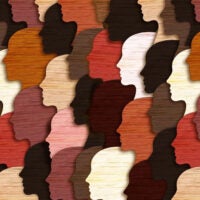
How an ‘impact mindset’ unites activists of different races
A new study finds that people’s involvement with Black Lives Matter stems from an impulse that goes beyond identity.
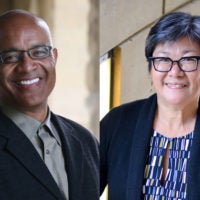
For democracy to work, racial inequalities must be addressed
The Stanford Center for Racial Justice is taking a hard look at the policies perpetuating systemic racism in America today and asking how we can imagine a more equitable society.
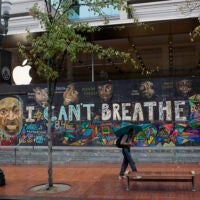
The psychological toll of George Floyd’s murder
As the nation mourned the death of George Floyd, more Black Americans than white Americans felt angry or sad – a finding that reveals the racial disparities of grief.

Seven factors contributing to American racism
Of the seven factors the researchers identified, perhaps the most insidious is passivism or passive racism, which includes an apathy toward systems of racial advantage or denial that those systems even exist.
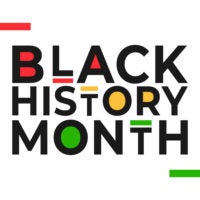
Scholars reflect on Black history
Humanities and social sciences scholars reflect on “Black history as American history” and its impact on their personal and professional lives.
The history of Black History Month
It's February, so many teachers and schools are taking time to celebrate Black History Month. According to Stanford historian Michael Hines, there are still misunderstandings and misconceptions about the past, present, and future of the celebration.

Numbers about inequality don’t speak for themselves
In a new research paper, Stanford scholars Rebecca Hetey and Jennifer Eberhardt propose new ways to talk about racial disparities that exist across society, from education to health care and criminal justice systems.

Changing how people perceive problems
Drawing on an extensive body of research, Stanford psychologist Gregory Walton lays out a roadmap to positively influence the way people think about themselves and the world around them. These changes could improve society, too.

Welfare opposition linked to threats of racial standing
Research co-authored by sociologist Robb Willer finds that when white Americans perceive threats to their status as the dominant demographic group, their resentment of minorities increases. This resentment leads to opposing welfare programs they believe will mainly benefit minority groups.

Conversations about race between Black and white friends can feel risky, but are valuable
New research about how friends approach talking about their race-related experiences with each other reveals concerns but also the potential that these conversations have to strengthen relationships and further intergroup learning.
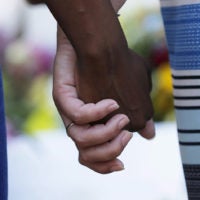
Defusing racial bias
Research shows why understanding the source of discrimination matters.
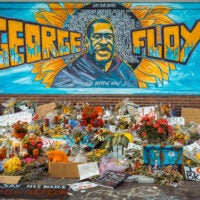
Many white parents aren’t having ‘the talk’ about race with their kids
After George Floyd’s murder, Black parents talked about race and racism with their kids more. White parents did not and were more likely to give their kids colorblind messages.

Stereotyping makes people more likely to act badly
Even slight cues, like reading a negative stereotype about your race or gender, can have an impact.

Why white people downplay their individual racial privileges
Research shows that white Americans, when faced with evidence of racial privilege, deny that they have benefited personally.

Clayborne Carson: Looking back at a legacy
Stanford historian Clayborne Carson reflects on a career dedicated to studying and preserving the legacy of civil rights leader Martin Luther King Jr.

How race influences, amplifies backlash against outspoken women
When women break gender norms, the most negative reactions may come from people of the same race.
Examining disparities in education
Scholar Subini Ancy Annamma is studying ways to make education more equitable for historically marginalized students. Annamma’s research examines how schools contribute to the criminalization of Black youths by creating a culture of punishment that penalizes Black children more harshly than their white peers for the same behavior. Her work shows that youth of color are more likely to be closely watched, over-represented in special education, and reported to and arrested by police.
“These are all ways in which schools criminalize Black youth,” she said. “Day after day, these things start to sediment.”
That’s why Annamma has identified opportunities for teachers and administrators to intervene in these unfair practices. Below is some of that research, from Annamma and others.

New ‘Segregation Index’ shows American schools remain highly segregated by race, ethnicity, and economic status
Researchers at Stanford and USC developed a new tool to track neighborhood and school segregation in the U.S.

New evidence shows that school poverty shapes racial achievement gaps
Racial segregation leads to growing achievement gaps – but it does so entirely through differences in school poverty, according to new research from education Professor Sean Reardon, who is launching a new tool to help educators, parents and policymakers examine education trends by race and poverty level nationwide.
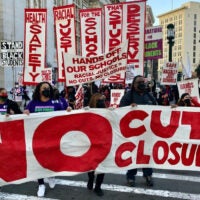
School closures intensify gentrification in Black neighborhoods nationwide
An analysis of census and school closure data finds that shuttering schools increases gentrification – but only in predominantly Black communities.

Ninth-grade ethnic studies helped students for years, Stanford researchers find
A new study shows that students assigned to an ethnic studies course had longer-term improvements in attendance and graduation rates.
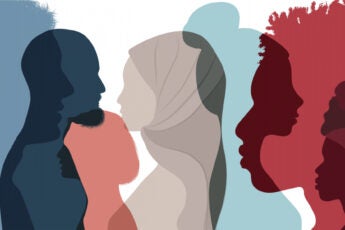
Teaching about racism
Stanford sociologist Matthew Snipp discusses ways to educate students about race and ethnic relations in America.

Stanford scholar uncovers an early activist’s fight to get Black history into schools
In a new book, Assistant Professor Michael Hines chronicles the efforts of a Chicago schoolteacher in the 1930s who wanted to remedy the portrayal of Black history in textbooks of the time.
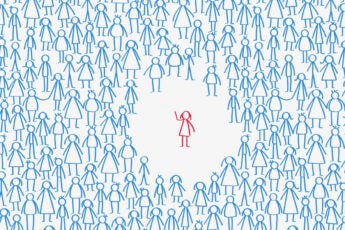
How disability intersects with race
Professor Alfredo J. Artiles discusses the complexities in creating inclusive policies for students with disabilities.

Access to program for black male students lowered dropout rates
New research led by Stanford education professor Thomas S. Dee provides the first evidence of effectiveness for a district-wide initiative targeted at black male high school students.

How school systems make criminals of Black youth
Stanford education professor Subini Ancy Annamma talks about the role schools play in creating a culture of punishment against Black students.

Reducing racial disparities in school discipline
Stanford psychologists find that brief exercises early in middle school can improve students’ relationships with their teachers, increase their sense of belonging and reduce teachers’ reports of discipline issues among black and Latino boys.

Science lessons through a different lens
In his new book, Science in the City, Stanford education professor Bryan A. Brown helps bridge the gap between students’ culture and the science classroom.

Teachers more likely to label black students as troublemakers, Stanford research shows
Stanford psychologists Jennifer Eberhardt and Jason Okonofua experimentally examined the psychological processes involved when teachers discipline black students more harshly than white students.
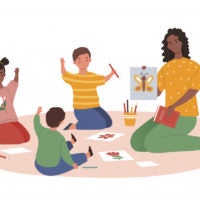
Why we need Black teachers
Travis Bristol, MA '04, talks about what it takes for schools to hire and retain teachers of color.
Understanding racism in the criminal justice system
Research has shown that time and time again, inequality is embedded into all facets of the criminal justice system. From being arrested to being charged, convicted and sentenced, people of color – particularly Black men – are disproportionately targeted by the police.
“So many reforms are needed: police accountability, judicial intervention, reducing prosecutorial power and increasing resources for public defenders are places we can start,” said sociologist Matthew Clair . “But beyond piecemeal reforms, we need to continue having critical conversations about transformation and the role of the courts in bringing about the abolition of police and prisons.”
Clair is one of several Stanford scholars who have examined the intersection of race and the criminal process and offered solutions to end the vicious cycle of racism. Here is some of that work.

Police Facebook posts disproportionately highlight crimes involving Black suspects, study finds
Researchers examined crime-related posts from 14,000 Facebook pages maintained by U.S. law enforcement agencies and found that Facebook users are exposed to posts that overrepresent Black suspects by 25% relative to local arrest rates.
Supporting students involved in the justice system
New data show that a one-page letter asking a teacher to support a youth as they navigate the difficult transition from juvenile detention back to school can reduce the likelihood that the student re-offends.

Race and mass criminalization in the U.S.
Stanford sociologist discusses how race and class inequalities are embedded in the American criminal legal system.
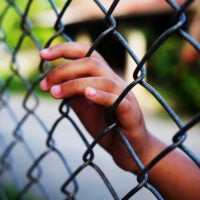
New Stanford research lab explores incarcerated students’ educational paths
Associate Professor Subini Annamma examines the policies and practices that push marginalized students out of school and into prisons.

Derek Chauvin verdict important, but much remains to be done
Stanford scholars Hakeem Jefferson, Robert Weisberg and Matthew Clair weigh in on the Derek Chauvin verdict, emphasizing that while the outcome is important, much work remains to be done to bring about long-lasting justice.

A ‘veil of darkness’ reduces racial bias in traffic stops
After analyzing 95 million traffic stop records, filed by officers with 21 state patrol agencies and 35 municipal police forces from 2011 to 2018, researchers concluded that “police stops and search decisions suffer from persistent racial bias.”


Stanford big data study finds racial disparities in Oakland, Calif., police behavior, offers solutions
Analyzing thousands of data points, the researchers found racial disparities in how Oakland officers treated African Americans on routine traffic and pedestrian stops. They suggest 50 measures to improve police-community relations.

Race and the death penalty
As questions about racial bias in the criminal justice system dominate the headlines, research by Stanford law Professor John J. Donohue III offers insight into one of the most fraught areas: the death penalty.
Diagnosing disparities in health, medicine
The COVID-19 pandemic has disproportionately impacted communities of color and has highlighted the health disparities between Black Americans, whites and other demographic groups.
As Iris Gibbs , professor of radiation oncology and associate dean of MD program admissions, pointed out at an event sponsored by Stanford Medicine: “We need more sustained attention and real action towards eliminating health inequities, educating our entire community and going beyond ‘allyship,’ because that one fizzles out. We really do need people who are truly there all the way.”
Below is some of that research as well as solutions that can address some of the disparities in the American healthcare system.
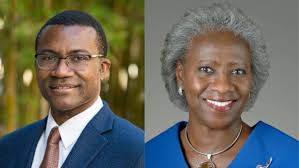
Stanford researchers testing ways to improve clinical trial diversity
The American Heart Association has provided funding to two Stanford Medicine professors to develop ways to diversify enrollment in heart disease clinical trials.

Striking inequalities in maternal and infant health
Research by SIEPR’s Petra Persson and Maya Rossin-Slater finds wealthy Black mothers and infants in the U.S. fare worse than the poorest white mothers and infants.

More racial diversity among physicians would lead to better health among black men
A clinical trial in Oakland by Stanford researchers found that black men are more likely to seek out preventive care after being seen by black doctors compared to non-black doctors.

A better measuring stick: Algorithmic approach to pain diagnosis could eliminate racial bias
Traditional approaches to pain management don’t treat all patients the same. AI could level the playing field.
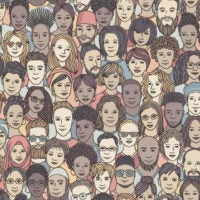
5 questions: Alice Popejoy on race, ethnicity and ancestry in science
Alice Popejoy, a postdoctoral scholar who studies biomedical data sciences, speaks to the role – and pitfalls – of race, ethnicity and ancestry in research.

Stanford Medicine community calls for action against racial injustice, inequities
The event at Stanford provided a venue for health care workers and students to express their feelings about violence against African Americans and to voice their demands for change.

Racial disparity remains in heart-transplant mortality rates, Stanford study finds
African-American heart transplant patients have had persistently higher mortality rates than white patients, but exactly why still remains a mystery.
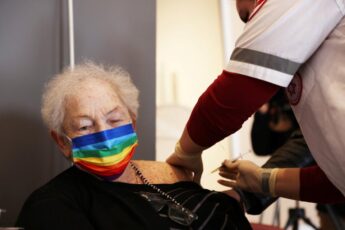
Finding the COVID-19 Victims that Big Data Misses
Widely used virus tracking data undercounts older people and people of color. Scholars propose a solution to this demographic bias.

Studying how racial stressors affect mental health
Farzana Saleem, an assistant professor at Stanford Graduate School of Education, is interested in the way Black youth and other young people of color navigate adolescence—and the racial stressors that can make the journey harder.

Infants’ race influences quality of hospital care in California
Disparities exist in how babies of different racial and ethnic origins are treated in California’s neonatal intensive care units, but this could be changed, say Stanford researchers.

Immigrants don’t move state-to-state in search of health benefits
When states expand public health insurance to include low-income, legal immigrants, it does not lead to out-of-state immigrants moving in search of benefits.

Excess mortality rates early in pandemic highest among Blacks
The impact of the COVID-19 pandemic has been starkly uneven across race, ethnicity and geography, according to a new study led by SHP's Maria Polyakova.
Decoding bias in media, technology
Driving Artificial Intelligence are machine learning algorithms, sets of rules that tell a computer how to solve a problem, perform a task and in some cases, predict an outcome. These predictive models are based on massive datasets to recognize certain patterns, which according to communication scholar Angele Christin , sometimes come flawed with human bias .
“Technology changes things, but perhaps not always as much as we think,” Christin said. “Social context matters a lot in shaping the actual effects of the technological tools. […] So, it’s important to understand that connection between humans and machines.”
Below is some of that research, as well as other ways discrimination unfolds across technology, in the media, and ways to counteract it.
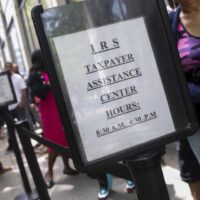
IRS disproportionately audits Black taxpayers
A Stanford collaboration with the Department of the Treasury yields the first direct evidence of differences in audit rates by race.

Automated speech recognition less accurate for blacks
The disparity likely occurs because such technologies are based on machine learning systems that rely heavily on databases of English as spoken by white Americans.
New algorithm trains AI to avoid bad behaviors
Robots, self-driving cars and other intelligent machines could become better-behaved thanks to a new way to help machine learning designers build AI applications with safeguards against specific, undesirable outcomes such as racial and gender bias.

Stanford scholar analyzes responses to algorithms in journalism, criminal justice
In a recent study, assistant professor of communication Angèle Christin finds a gap between intended and actual uses of algorithmic tools in journalism and criminal justice fields.
Move responsibly and think about things
In the course CS 181: Computers, Ethics and Public Policy , Stanford students become computer programmers, policymakers and philosophers to examine the ethical and social impacts of technological innovation.

Homicide victims from Black and Hispanic neighborhoods devalued
Social scientists found that homicide victims killed in Chicago’s predominantly Black and Hispanic neighborhoods received less news coverage than those killed in mostly white neighborhoods.

Algorithms reveal changes in stereotypes
New Stanford research shows that, over the past century, linguistic changes in gender and ethnic stereotypes correlated with major social movements and demographic changes in the U.S. Census data.

AI Index Diversity Report: An Unmoving Needle
Stanford HAI’s 2021 AI Index reveals stalled progress in diversifying AI and a scarcity of the data needed to fix it.
Identifying discrimination in the workplace and economy
From who moves forward in the hiring process to who receives funding from venture capitalists, research has revealed how Blacks and other minority groups are discriminated against in the workplace and economy-at-large.
“There is not one silver bullet here that you can walk away with. Hiring and retention with respect to employee diversity are complex problems,” said Adina Sterling , associate professor of organizational behavior at the Graduate School of Business (GSB).
Sterling has offered a few places where employers can expand employee diversity at their companies. For example, she suggests hiring managers track data about their recruitment methods and the pools that result from those efforts, as well as examining who they ultimately hire.
Here is some of that insight.

How To: Use a Scorecard to Evaluate People More Fairly
A written framework is an easy way to hold everyone to the same standard.
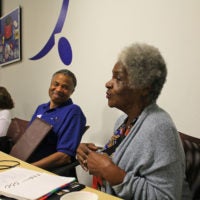
Archiving Black histories of Silicon Valley
A new collection at Stanford Libraries will highlight Black Americans who helped transform California’s Silicon Valley region into a hub for innovation, ideas.

Race influences professional investors’ judgments
In their evaluations of high-performing venture capital funds, professional investors rate white-led teams more favorably than they do black-led teams with identical credentials, a new Stanford study led by Jennifer L. Eberhardt finds.

Who moves forward in the hiring process?
People whose employment histories include part-time, temporary help agency or mismatched work can face challenges during the hiring process, according to new research by Stanford sociologist David Pedulla.

How emotions may result in hiring, workplace bias
Stanford study suggests that the emotions American employers are looking for in job candidates may not match up with emotions valued by jobseekers from some cultural backgrounds – potentially leading to hiring bias.

Do VCs really favor white male founders?
A field experiment used fake emails to measure gender and racial bias among startup investors.

Can you spot diversity? (Probably not)
New research shows a “spillover effect” that might be clouding your judgment.

Can job referrals improve employee diversity?
New research looks at how referrals impact promotions of minorities and women.
398 Racism Essay Titles & Writing Examples
- 🔖 Secrets of Powerful Racism Essay
🏆 Best Racism Topic Ideas & Essay Examples
🥇 most interesting racism topics to write about, 🎓 simple & easy racism essay titles, ⚡ shocking essay topics on racism, 👍 good essay topics on racism, 💡 interesting essay titles about racism, ❓ racism questions for essay.
Looking for powerful racism essay topics? You will find them here! This list contains a great variety of titles for racism-themed papers. We’ve also included useful tips and plenty of racism essay examples to help you write an outstanding paper.
🔖 Secrets of a Powerful Racism Essay
Writing an essay on racism may seem easy at first. However, because racism is such a popular subject in social sciences, politics, and history, your piece needs to be truly powerful to receive a high mark. Here are the best tips to help make your racism essay stand out:
- Consider the historical causes of racism. Papers on racism often focus on discrimination and equality in modern society. Digging a bit deeper and highlighting the origins of racism will make your essay more impressive. Check academic resources on the subject to see how racism was connected to the slave trade, politics, and social development in Europe. Explore these ideas in your paper to make it more compelling!
- Show critical thinking. Racism essay titles often focus on the effects of racism on the population. To make your essay more powerful, you will need to discuss the things that are often left out. Think about why racial discrimination is still prevalent in modern society and who benefits from racist policies. This will show your tutor that you understand the topic in great depth.
- Look for examples of racism in art. One of the reasons as to why racism spread so quickly is because artists and authors supported the narratives of race. If you explore paintings by European artists created in 17-18 centuries, you will find that they often highlighted the differences between black and white people to make the former seem less human. In various literary works, such as Conrad’s Heart of Darkness and Shakespeare’s Othello, racism plays a vital role. In contrast, more recent works of art consider racism from a critical viewpoint. Examining how racism is reflected in the art will help you to earn an excellent mark for your analysis of the subject.
- Discuss the influences of racism. Of course, one of the key racism essay topics is the impact of racism on black populations in various countries. It is true that discrimination plays an essential role in the lives of black people, and reflecting this in your paper will help you to make it influential. You can discuss various themes here, from police brutality to healthcare access. Support your claims with high-quality data from official sources. If appropriate, you can also show how racism affected your life or the lives of your friends and loved ones.
- Show the correlation between racism and other social issues. Racism is connected to many different types of discrimination, including sexism and homophobia. This allows you to expand your paper by showing these links and explaining them. For instance, you could write an essay on racism and xenophobia, or find other topics that interest you.
Finally, structure your essay well. Write an outline first to determine the sequence of key points. You can check out a racism essay example on this website to see how other people structure their work.
Racism Thesis Statement, Main Body, & Conclusion
A typical essay should have an introduction, the main body, and a conclusion. Each paragraph of the main body should start with a topic sentence. Here’s what a topic sentence for racism-themed essay can look like:
Racism continues to be a pervasive issue in society, with deep-rooted prejudices and discrimination that impact individuals and communities across the globe.
Don’t forget to include a racism essay thesis statement at the end of your introduction to identify the focus of the paper! Check out these racism thesis statements for inspiration:
Racism is pervasive social problem that manifests in various forms, perpetuating systemic inequalities and marginalizing minority groups. Through an examination of racism’s history and its psychological impact on individuals, it becomes evident that this pressing issue demands collective action for meaningful change.
In your essay’s conclusion, you can simply paraphrase the thesis and add a couple of additional remarks.
These guidelines will help you to ensure that your work is truly outstanding and deserving of a great mark! Be sure to visit our website for more racism example essays, topics, and other useful materials.
These points will help you to ensure that your work on racism is truly influential and receives a great mark! Be sure to visit our website for example papers, essay titles, and other useful materials.
- The Challenges of Racism Influential for the Life of Frederick Douglass and Barack Obama However, Douglass became an influential anti-slavery and human rights activist because in the early childhood he learnt the power of education to fight inequality with the help of his literary and public speaking skills to […]
- Racism in “The Adventures of Huckleberry Finn” by Mark Twain The character of Pap is used to advance the theme of racism in the book. In the closing chapters of the book, Huck and Tom come to the realization that Jim is not property but […]
- Racism in Music: “(What Did I Do to Be So) Black and Blue” The extreme popularity of the song among the black population can be explained with references to the fact that Armstrong changed the original lyrics to accentuate the social meaning of the composition and elaborated the […]
- Racism in “The Black Table Is Still There” by Graham The black table, as he calls it, is a table, that was and still is, present in his school’s cafeteria, that accommodated the black students only depicting no more than racism in schools.
- Racism in the “Dutchman” by Amiri Baraka Generally, one is to keep in mind that Baraka is recognized to be one of the most important representatives of the black community, and the theme of racism in The Dutchman has, therefore, some historical […]
- Racism and Discrimination as Social Constructs This is because the concept of race has a negative connotation in the society. For example in some societies, especially the western society; the concept of race implies un-fair treatment and discrimination of a particular […]
- Maya Angelou: Racism and Segregation in “I Know Why the Caged Bird Sings” An example is that, as she fails to recite her poem in church, she notes that her dress is probably a handout from a white woman.
- Racism and Motherhood Themes in Grimke’s “Rachel” In addition, her mother kept the cause of the deaths of Rachel’s father and brother secret. In essence, the play Rachel is educative and addresses some of the challenges people face in society.
- Racial Discrimination in “A Raisin in the Sun” Racial discrimination is the main theme of the book, strongly reflecting the situation that prevailed during the 1950s in the United States, a time when the story’s Younger family lived in Chicago’s South Side ghetto.
- Contrast Between Tituba and John Indian and Countering Racism The declaration suggests that Conde believed the story of Tituba’s maltreatment needed to be told to expose the truth she had been denied due to her skin color and gender.
- Cause and Effect of Racial Discrimination Irrespective of massive efforts to emphasize the role of diversity and equality in society, it is still impossible to state that the United States is free from racial discrimination.
- Imperialism and Racism in Joseph Conrad’s Heart of Darkness He lauds “the book’s anti-imperialist theme…a stinging indictment of the callous and genocidal treatment of the Africans, and other nationals, at the hands of the British and the European imperial powers,” and also details the […]
- The Anatomy of Scientific Racism: Racialist Responses to Black Athletic Achievement Miller is of the view that it is the white scholars that are responsible for impeding the success of black athletes and performers.
- Racial Discrimination Effects in Coming of Age in Mississippi by Anne Moody The vivid description of events from the beginning gives the reader a clear picture of a girl who was born in problems and in spite of her intelligence she always became a victim of circumstances.
- Racism in Shakespeare’s “Othello” and Dick’s “Do Androids Dream of Electric Sheep?” The formalist analysis of Do Androids Dream of Electric Sheep repeats the same mistake, as it focuses on the plot devices and tropes presented in the story.
- Racism and Gender in Beyoncé’s Lemonade The album Lemonade by an American singer Beyonce is one of the brightest examples when an artist portrays the elements of her culture in her music. Along with music videos, the album features a number […]
- Racism in “Passing” and “Uncle Tom’s Children” Novels Therefore, the evolution of the society gave rise to the reconsideration of the approach to racism and promoted the increase of the level of consciousness of the discriminated people.
- Black or White Racism When one listens to the “Black or White” song, it is clear that Michael Jackson is not expecting his audience to be either white or black people to listen and learn the message he is […]
- Colonialism and Racism in Foe by J. M. Coetzee and Small Island by Andrea Levy This paper will try to expound on the relevance of real-life politics, of colonialism and racism, with regards to two popular works of fiction that used as themes or backdrop colonialism and racism.
- Sexism, Racism, Ableism, Ageism, Classism The absurdity and blatant sexism of this issue made me angry at how the United States is unable to resolve and overcome the lack of gender equality.
- Racial Discrimination Through the Cosmetics Industry The variety of preconceptions such as the hypersexuality of black women and the perception of their beauty as an unideal version of whites’ one also indicates racism.
- The Problem of Racism in Brazilian Football Skidmore describes it as the relationships that could result into conflict and consciousness and determination of the people’s status in a community or a particular group. In football, racism damages pride of the players and […]
- Does Racism and Discrimination Still Exist Today? This fact explains why racism and discrimination are inseparable in many parts of the globe. Sex discrimination continues to affect the goals and expectations of many women in our society.
- The Problem of Racism and Injustice in To Kill a Mockingbird by Harper Lee In the novel, Harper Lee demonstrates her vision of the question of the social inequality with references to the problem of racism in the society based on prejudice and absence of actual principles of tolerance […]
- Root Causes and Solutions to Racism Media is meant to eradicate racism and maintain unity among people but the case is different in some situations. Also, it is vital to make children understand nothing is amusing in the use of stereotypes […]
- Racism Effects on the Premier League Players This work aims to provide a full picture of the real issue, and it is fundamental to understand the essence of the problem through the investigation of the players’ personal opinions and their experiences.
- How Racism Makes Us Sick: Public Talk That Matters As a developing learner, I find this speech as a good example of how to raise such provocative themes as racism in the United States and not to be obsessed with prejudice.
- Racism in Play “Othello” by William Shakespeare Since Othello is dark-skinned, the society is against his marriage to the daughter of the senator of Venice. In summary, the play Othello is captivating and presents racism as it was.
- Colin Powell and the Fight Against Structural Racism When donating his uniform to the National Museum of African American History and Culture, Powell stated that the museum is a “treasure” the significance of which extends borders of the country.
- Racism: De Brahm’s Map and the Casta Paintings However, De Brahm’s map is one of the most striking pieces of evidence of the conquest of space and the entrenchment of the idea of land and people as titular property.
- Racism and Inequality in Society The idea of race as a social construct is examined in the first episode of the documentary series “The Power of an Illusion”.
- Anti-Racism: Marginalization and Exclusion in Healthcare This essay examines the course’s impact and the concepts of marginalization and exclusion in healthcare. Marginalization is a concept that has profoundly influenced the understanding of race and racism in healthcare.
- The Issue of Racism in the United States The entire history of the United States is permeated with the evolution of the ideas of racism. Turning to history, we can see that the U.S.moved from slavery to using the Black population to solve […]
- History of Racial Discrimination in Haiti and America The choice of topic, racial discrimination in Haiti and America, was influenced by beliefs, values, and assumptions emphasizing the importance of equality and justice for all races.
- Racism and History of Discrimination As a result, advocacy should be aimed at creating new models in criminal justice that will ensure the protection of all minority groups and due process.
- Racial Discrimination and Color Blindness Of the three ideologies, racial harmony is considered the most appropriate for coping with problems of racism and racial injustice due to various reasons.
- Race, Racism, and Dangers of Race Thinking While it is true that some forms of race thinking can be used to justify and perpetuate racism, it is not necessarily the case that all forms of race thinking are inherently racist. Race thinking […]
- Racial Discrimination in American Literature In this way, the author denies the difference between people of color and whites and, therefore, the concept of racism in general.
- Racism in the US: Settler Imperialism They prove that colonial imperialism is a structure, not a contextual phenomenon and that, as such, it propagates the marginalization of native people.
- Why Empathy in Racism Should Be Avoided Empathy is the capacity to comprehend and experience the emotions and ideas of others. Moreover, empathic emotions are essential to social and interpersonal life since they allow individuals to adapt their cognitive processes to their […]
- Racial Discrimination in High Education This peer-reviewed scholar article was found in the JSTOR database through entering key words “race affirmative action” and marking the publication period between 2017 and 2022.
- Social Sciences: Racism Through Different Lenses A thorough analysis of diversity adds value to social interactions by informing human behavior through a deeper understanding of racism and its impacts on society. Using the humanities lens leads to a better understanding of […]
- Racial Discrimination in Dormitory Discrimination is considered to be behavior that restricts the rights and freedoms of the individual. Therefore, it is essential to investigate discrimination in dormitories and propose solutions to this problem, such as disseminating knowledge about […]
- Racism and Its Impact on Populations and Society The ignorance of many individuals about other people’s cultures and ethnicities is one of the causes of racism. One can examine the various components of society and how they relate to the issue of racism […]
- Institutionalized Racism and Individualistic Racism Excellent examples of individualistic racism include the belief in white supremacy, racial jokes, employment discrimination, and personal prejudices against black people. Overall, institutionalized and individualistic racism is a perversive issue that affects racial relations in […]
- Community Engagement with Racism To enhance the population’s degree of involvement in racism, the study calls for collaboration; this can be seen as a community effort to foster a sense of teamwork.
- Racism Detection with Implicit Association Test Racial bias is deeply rooted in human society and propelled by norms and stereotypic ideologies that lead to implicit bias and the unfair treatment of minority groups.
- Identity and Belonging: Racism and Ethnicity In the documentary Afro Germany – Being Black and German, several individuals share their stories of feeling mistreated and excluded because of their skin color.
- Policies to Eliminate Racial Disparities and Discrimination The solution to exclusion is to build social inclusion in the classroom and within the school by encouraging peer acceptance, cross-group friendships, and built-in prevention.
- Causes, Facilitators, and Solutions to Racism These theories suggest that racism serves a particular function in society, occurs due to the interactions of individuals from dominant groups, and results from a human culture of prejudice and discrimination.
- Racial Discrimination and Justice in Education An example is the complaint of the parents of one of the black students that, during the passage of civilizations, the Greeks, Romans, and Incas were discussed in the lessons, but nothing was said about […]
- Empathy and Racism in Stockett’s The Help and Li’s To Kill a Mockingbird To start with, the first approach to racism and promoting empathy is to confront prevalent discrimination and racism, which was often shown in The Help. Another solution to racism and the possibility of promoting empathy […]
- Is Troy Maxson (Wilson’s Fences) a Victim of Racism? As a black American, Troy’s childhood experiences have been passed on to his children, making him a victim of an oppressive culture. Therefore, this makes Troy a victim of racism and culture, contributing to his […]
- Racism in the Healthcare Sector In 2020, the cases and instances of racism in healthcare rose by 16% from 2018; there were notable instances of racism in various spheres of health. 9% of blacks have been protected from discrimination and […]
- Racism in Healthcare and Education The mission should emphasize that it promotes diversity and equality of all students and seeks to eliminate racial bias. It is necessary to modify the mission to include the concept of inclusiveness and equality.
- Institutional Racism in the Workplace Despite countless efforts to offer African-Americans the same rights and opportunities as Whites, the situation cannot be resolved due to the emergence of new factors and challenges.
- Racism in Education in the United States Such racial disparities in the educational workforce confirm the problem of structural racism and barrier to implementing diversity in higher medical education. Structural racism has a long history and continues to affect the growth of […]
- Rhetoric in Obama’s 2008 Speech on Racism When the audience became excited, it was Obama’s responsibility to convey his message in a more accessible form. To conclude, Obama’s speech in 2008 facilitated his election as the first African American President in history.
- How to Talk to Children About Racism The text begins by referring to recent events that were related to race-based discrimination and hatred, such as the murder of George Floyd and the protests dedicated to the matter.
- Care for Real: Racism and Food Insecurity Care for Real relies on the generosity of residents, donation campaigns, and business owners to collect and deliver these supplies. The research article discusses some of the factors that contribute to the creation of racism […]
- Racism Towards Just and Holistic Health Therefore, the critical content of the event was to determine the steps covered so far in the fight for racial equality in the provision of care and what can be done to improve the status […]
- Racism and Related Issues in Canadian Society The first issue is that it does not review the systemic and structural aspects of racism and how it affects various institutions and society as a whole.
- Systemic Racism and Discrimination Thus, exploring the concept of race from a sociological perspective emphasizes the initial aspect of inequality in the foundation of the concept and provides valuable insight into the reasons of racial discrimination in modern society.
- The Racism Problem and Its Relevance The images demonstrate how deeply racism is rooted in our society and the role the media plays in spreading and combating racism.
- Aspects of Socio-Economic Sides of Racism And the answer is given in Dorothy Brown’s article for CNN “Whites who escape the attention of the police benefit because of slavery’s long reach”.. This shows that the problem of racism is actual in […]
- Tackling Racism in the Workplace It means that reporting racism to HR does not have the expected positive effect on workplace relations, and employees may not feel secure to notify HR about the incidences of racism.
- Issue of Racism Around the World One of the instances of racism around the world is the manifestations of violence against indigenous women, which threatens the safety of this vulnerable group and should be mitigated.
- The Racism Problem and How to Fight It Racism is one of the common problems of the modern world which might not allow several individuals to feel a valuable part of society due to their skin color, gender, or social status.
- Environmental Racism: The Water Crisis in Flint, Michigan The situation is a manifestation of environmental racism and classism since most of the city’s population is people of color and poor. Thus, the water crisis in Flint, Michigan, is a manifestation of environmental racism […]
- The “Racism and Discrimination” Documentary The documentary “Racism and Discrimination” is about an anti-racist teacher Jane Elliot who attempts to show the white people the feeling of discrimination. The central argument of the documentary is diversity training to seize the […]
- Abortion-Related Racial Discrimination in the US In spite of being a numerical minority, Black women in the U.S.resort to abortion services rather often compared to the White population.
- Social Problems Surrounding Racism, Prejudice and Discrimination This kind of discrimination makes the students lose their self-esteem and the traumas experienced affects the mental health of these students in the long term.
- Racism and Intolerance: The 1921 Tulsa Race Massacre The 1921 Tulsa Race Massacre: Crafting a Legacy by Messer elaborates on the legacy of the event and its repercussions and offers a profound analysis of the issue, which strengthened my focus of the research.
- The Unethical Practice of Racism in a Doctor’s Case The involvement of Barrett in the protest is both unethical for the university’s image and immoral for the community. However, the school would likely face tougher court fines and a direct order to reinstate Barrett’s […]
- The Problem of Racism in America One explanation of racism by feminist thinkers is that racism is a manifestation of the agency and power of people of a particular racial identity over others.
- Racism: “The Sum of Us” Article by McGhee The economic analysis and sociological findings in America have drawn a detailed picture of the cost of racism in America and how to overcome it together.
- Contemporary Sociological Theories and American Racism The central intention of this theory paper is to apply modern theoretical concepts from the humanities discipline of sociology to the topic of racism in the United States.
- A Cause-and-Effect Analysis of Racism and Discrimination As a result, it is vital to conduct a cause-and-effect analysis to determine the key immediate and hidden causes of racism to be able to address them in a proper manner.
- Institutional Racism Through the Lenses of Housing Policy While not being allowed to buy property because of the racial covenants, the discriminated people had to house in other areas.
- Role of Racism in Contemporary US Public Opinion This source is useful because it defines racism, describes its forms, and presents the survey results about the prevalence of five types of racial bias.
- The Mutation of Racism into New Subtle Forms The trend reflects the ability of racism to respond to the rising sensitivity of the people and the widespread rejection of prejudice.
- Racism: Healthcare Crisis and the Nurses Role The diminished admittance to mind is because of the impacts of fundamental bigotry, going from doubt of the medical care framework to coordinate racial segregation by medical care suppliers.
- Origins of Racial Discrimination Despite such limitations as statistical data being left out, I will use this article to support the historical evaluation of racism in the United States and add ineffective policing to the origins of racism.
- Beverly Greene Life and View of Racism The plot of the biography, identified and formed by the Ackerman Institute for the Family in the life of the heroine, consists of dynamics, personality development and its patterns.
- Historical Racism in South Africa and the US One of the major differences between the US and South Africa is the fact that in the case of the former, an African American minority was brought to the continent to serve the White majority.
- Capitalism and Racism in Past and Present Racism includes social and economic inequalities due to racial identity and is represented through dispossession, colonialism, and slavery in the past and lynching, criminalization, and incarceration in the present.
- Minstrels’ Influence on the Spread of Racism The negative caricatures and disturbing artifacts developed to portray Black people within the museum were crucial in raising awareness on the existence of racism.
- How Parents of Color Transcend Nightmare of Racism Even after President Abraham Lincoln outlawed enslavement and won the American Civil War in 1965, prejudice toward black people remained engrained in both the northern and southern cultural structures of the United States.
- A Problem of Racial Discrimination in the Modern World This minor case suggests the greater problem that is unjustly treating people in the context of the criminal justice system. In the book, Stevenson writes about groups of people who are vulnerable to being victimized […]
- Beverly Tatum’s Monolog About Injustice of Racism Furthermore, the author’s point is to define the state of discrimination in the country and the world nowadays and explore what steps need to be taken to develop identity.
- Issue of Institutional Racism Systemic and structural racisms are a form of prejudice that is prevalent and deeply ingrained in structures, legislation, documented or unpublished guidelines, and entrenched customs and rituals.
- Racism in America Today: Problems of Today Even though racism and practices of racial discrimination had been banned in the 1960s after the mass protests and the changes to the laws that banned racial discrimination institutionally.
- Evidence of Existence of Modern Racism It would be wrong to claim that currently, the prevalence and extent of manifestations of racism are at the same level as in the middle of the last century.
- Culture Play in Prejudices, Stereotyping, and Racism However, cognitive and social aspects are significant dimensions that determine in-group members and the constituents of a threat in a global religious view hence the relationship between religion and prejudices.
- Latin-African Philosophical Wars on Racism in US Hooker juxtaposition Vasconcelos’ ‘Cosmic Race’ theory to Douglass’s account of ethnicity-based segregation in the U.S.as a way of showing the similarities between the racial versions of the two Americas.
- Confronting Stereotypes, Racism and Microaggression Stereotypes are established thought forms rooted in the minds of particular groups of people, in the social environment, and in the perception of other nations.
- Racial Discrimination in Dallas-Fort Worth Region Thus, there is a historical imbalance in the political representation of racial minorities in the Dallas-Fort Worth area. Nonetheless, the Black population is reported to thrive best in the suburban areas of DFW, where this […]
- Healthcare Call to Action: Racism in Medicine To start the fight, it is necessary to identify the main manifestations of discrimination in health care, the reasons for the emergence of the location of social superiority and discrimination, and the scale.
- White Counselors Broaching Race and Racism Study The essence of the verbal behavior of the consultants is the ways of their reaction in the process of interaction with the client – the basic skills of counseling, accessibly including race and racism topics.
- British Colonial Racism for Aboriginal Australians Precisely this colonial racism and genocide can be considered to be the cruelest in the history of the world and may have influenced the ideas and plans of Adolf Hitler, who got inspired by the […]
- American Culture and Its Racism Roots However, the discrimination seems not to be justified since many shreds of evidence show that many Americans are thought to be immigrants to the continent, with the first immigrants being the Spanish and the French.
- The Black People: Sexuality and Racial Discrimination Nevertheless, the author does not provide practical solutions to the issue of racism and discrimination of the LGBTQ community. The purpose of this interview is to demonstrate the author’s attitude to the sexuality of black […]
- Racism Evolution: Experience of African Diaspora As a result, distinct foundations fostered the necessity of inequality to establish effectiveness of inferiority and superiority complexes. To determine the effect of slavery and racism to modern society.
- The Problem of Explicit Racism The murder of George Floyd was one example of the police’s brutal racism, and there are many more cases of horrible discrimination that takes people’s lives.
- Racial Discrimination and Residential Segregation Despite the end of segregation policies and the passing of Fair Housing laws and numerous subsidy measures, people of color cannot access wealthy areas, facing unofficial exclusion into poorer parts of the city.
- Significance of Perceived Racism:Ethnic Group Disparities in Health Coates points out that a sign of the gulf between blacks and whites manifests in the context where there is expectation for him to enlighten his opinions while in mind the essential indication lies in […]
- Racism as Origin of Enslavement Some ideas are mentioned in the video, for example, the enslavement of Black people and their children. The most shocking fact mentioned by the speaker of the video is that children of enslaved people were […]
- Colorblind Racism and Its Minimization Colorblind racism is a practice that people use to defend themselves against accusations of racism and deny the significance of the problem.
- Legacy of Racism Against African American Women and Men This was a movie called The Birth of A Nation which supposedly tells ‘the American history.’ The white men who praised the Ku Klux Klan were shown as superior and intelligent.
- The Bill H.R.666 Anti-Racism in Public Health Act of 2021 That is why the given paper will identify a current and health-related bill and comment on it. This information demonstrates that it is not reasonable to oppose passing the bill under consideration.
- Summary of the Issue About Racism In schools in the United States, with the advent of the new president, a critical racial theory began to be taught.
- How the Prison Industrial Complex Perpetuate Racism In the United States, the system is a normalization of various dynamics, such as historical, cultural, and interpersonal, that routinely benefit the whites while causing negative impacts for the people of color.
- Battling Racism in the Modern World Racism and racial discrimination undermine the foundations of the dignity of an individual, as they aim to divide the human family, to which all peoples and people belong, into different categories, marking some of them […]
- Indian Youth Against Racism: Photo Analysis The main cause of racism within American societies is the high superiority complex possessed by the white individuals living with the Asian American in the society.
- Racism: Do We Need More Stringent Laws? The Civil Rights Division of the Department of Justice is worried that national origin discrimination in the U.S.may go undetected because victims of prejudice are unaware of their legal rights or are hesitant to complain […]
- Problem of Racism in Schools Overview Racism should be discouraged by all means and the government should do its best to educate citizens on the importance of unity and the disadvantages of racism.
- US Immigration Policy and Its Correlation to Structural Racism That may create breaches in the immigration policy and cause social instability that could endanger the status of immigrants and even negatively affect the lives of the nationals.
- America: Racism, Terrorism, and Ethno-Culturalism The myth of the frontier is one of the strongest and long-lived myths of America that animates the imagination of the Americans even to this day.
- Racism in Healthcare and Its Implications Generally, the presence of racism in the medical sphere affects not only the relationship between the a professional and their patient, but also the quality of care people receive and the severity of their outcomes.
- Issue of Racism in Healthcare The theory would question whether racism in healthcare is ethical and whether it facilitates the provision of care in a manner that is centered on values such as compassion, fairness, and integrity.
- Racism and Statistical & Pure Discrimination For employers, the residents of the inner city are likely to be associated with criminal activity, as well as a lack of education and skills.
- Solving Racial Discrimination in the US: The Best Strategies The Hollywood representation of a black woman is often a magical hero who “is a virtuous black character who serves to better the lives of white people…and asks nothing for herself”.
- Popular Music at the Times of Racism and Segregation The following work will compare and contrast the compositions of Louis Armstrong and Scott Joplin and examine the impact of racism on popular music.
- Temporary Aid Program: Racism in Child Welfare The purpose of this paper is to analyze the Temporary Assistance for Needy Families program in the context of child welfare disparities.
- The Problem of Racism in the Police Force Atiba argues that the problem of racism, especially in the police force, is solvable. In most of the cases, it is often interpreted as lack of love and compassion towards people of the other race.
- Western Scientific Approach as a Cause of Racism This paper will highlight the main methods of refuting the works of racist anthropologists and how they influenced the emergence of stereotypes about people of color.
- How Does Racism Affect Health? Many people of color experience internalized racism, which can lead to anxiety and depression that can be the cause of physical issues.
- Citizen: An American Lyric and Systemic Racism In essence, the primary objective of the author is to trigger the readers’ thoughts towards the devastating racism situation in America and the world in general.
- The Reflection of Twain’s Views on Racism in Huck Finn One of the most problematic aspects in the novel that potentially can make readers think that Twain’s attitude toward slavery and racism is not laudable is the excessive usage of the n-word by all sorts […]
- Black as a Label: Racial Discrimination People are so used to identifying African Americans as black that they refuse to accept the possibility of the artificiality of labeling.
- The Tennessee Valley Authority (TVA) and Racial Discrimination The author argues that despite increasing the overall prosperity of the local communities, the policies and projects of the Tennessee Valley Authority did not address the well-being of the white population and Afro-American citizens equally.
- Flint Water Crisis: Environmental Racism and Racial Capitalism The Flint crisis is a result of the neoliberal approach of the local state as opposed to the typical factors of environmental injustice; a polluter or a reckless emitter cutting costs. The two main factors […]
- Cancer Alley and Environmental Racism One of the sources under study is valuable, as it examines the current situation of the coronavirus and the impact of pollution on human health.
- Cancer Alley and Environmental Racism in the US Bentlyewski and Juhn argue that the environmental racism in the country has been the result of aligning the public environmental policy and industrial activity to benefit the white majority and, at the same time, shifting […]
- American Healthcare in the Context of Racism According to the researchers, the fundamental issue of racism in health care is the practitioners and public health representatives’ lack of desire to recognize the health specifics of racial and ethnic minorities, which results in […]
- Origins of Modern Racism and Ancient Slavery The diversity of African kingdoms and the empires were engaged in the slave trade for hundreds of years prior to the beginnings of the Atlantic slave trade. The working and living condition of slaves were […]
- Contribution of Racism to Economic Recession Due to COVID-19 The historical injustice accounts for unequal employment opportunities and the economic profile of the minority groups. Therefore, economic recovery for the older Latinos and Blacks is limited due to the lack of flexible occupational benefits.
- What Stories Can Teach Us About Racism On top of this before the establishment of the school there was no public education for the Negro children and this made it more difficult for the children to access education just like the other […]
- Racism in Canadian Medical System The difference in the treatment of indigenous and non-indigenous individuals in Canada is a result of racism in the medical facility.
- Profit and Racism in the Prisons of the United States As an argument for the work of prisoners, the prison of Angola makes the argument that work is a way of rehabilitation for the prisoner.
- Rio Tinto: Case Study About Racism and Discrimination The repercussions of this situation for the preservation of cultural heritage may be considerable, as the expert community was denied an opportunity to research the artifacts.
- Racism: US v. The Amistad and Dred Scott v. Sandford In legal terms, the key difference between the two was that the Africans from Amistad were freeborn and enslaved in violation of the international agreements, while Dred Scott, despite his sojourn in Illinois, was born […]
- Critical Social Problems Research: Racism and Racial Domination According to his opinion, which is proven today by many examples including the attitude of the authorities, people of color are treated as if they are worthless and not destined to achieve success.
- Criminal Justice: Racial Prejudice and Racial Discrimination Souryal takes the reader through the racial prejudice and racial discrimination issues ranging from the temperament of racism, the fundamental premise of unfairness, the racial biasness and the causes of racial unfairness to ethical practices […]
- Gonzalez v. Abercrombie & Fitch Discrimination Racism Lawsuit: An Analysis The case was filed in June 2003, and the claim was that this company has grossly violated the rights of the citizens as provided for in the constitution of the country.
- The History of Racial Discrimination and Its Effects on the American Races The saddest part of it all is that our Indian American brothers are discussed in public and used as examples in a manner that makes it seem like they exist only as a mere caricature […]
- Racial Discrimination in the US Criminal Justice System This report argues that when one studies the proportion of blacks in the Cincinnati community and the number of times that they have been stopped for traffic violations, one finds that there is a large […]
- Policing in America: The Issue of Violence and Racism While the former proposition has various negative aspects to be considered, the latter appears to be the appropriate reaction to the challenges posed for the United States’ society in 2020.
- Institutional and Interpersonal Racism, White Privilege One should be aware of the fact that issues such as institutional and interpersonal racism, privilege, power, and bias are complex problems, which need a thorough analysis and consideration of all the facts.
- Anti-Racism in Shakespeare’s Othello For Shakespeare, Brabantio’s views are representative of the racial prejudice of the society in general, rather than of his personal feelings towards the protagonist. On the other hand, Othello’s story is cohesive and believable; he […]
- Racism and Sexism as a Threat Women suffer from sexism, people of color are affected by racism, and women of color are victims of both phenomena. Prejudices spread in families, communities, and are difficult to break down as they become part […]
- The Development of a Measure to Assess Symbolic Racism The originators of the concept applied it only to the African-American race, while other scientists engaged in researching and applying the construct of symbolic racism to other races and cultures.
- Racism and Tokenism in Bon Appetit: Leadership and Ethical Perspective Leadership is defined as a set of actions and beliefs of a manager who directs and controls the followers to achieve a common goal.
- From “Scientific” Racism to Local Histories of Lynching Both chapters serve as a premise to the following arguments in the book, arguing that White power is still dominant in the contemporary world, and give context to the broader scale of oppression worldwide.
- Subjective Assumptions and Medicine: Racism The given supposition demonstrates that Allen believed in the superiority of white southerners over Black Americans because the latter ones were made responsible for the deteriorated health of the former.
- Racism Experiences in the Workplace in the UK This research paper provides the background of racism in the UK, particularly in the area of employment. The UK struggles against racial discrimination and paves the way to equity and inclusion in the area of […]
- The History of Immigration to the United States and the Nature of Racism The development of the idea of race and ethnicity along with the idea of racial antagonism has two main stages in the history of the United States.
- Race and Racism in the USA: The Origins and the Future In conclusion, the author suggests that the possible solution to the problem of racial conflicts is the amalgamation of different races and ethnics.
- Racially Insensitive Name-Calling in Classroom Probably, the teacher had to initiate the lesson devoted to the topic of racial discrimination and to think over all the stages of the discussion, to organize it in a polite and friendly manner.
- Environmental Racism in the United States: Concept, Solution to the Problem With regards to this definition, a row of issues connected to social justice and the equality in the rights of people which is firmly established in the Constitution of the United States are to be […]
- Protecting George Wallace’s Organized Racism
- How Can the World Unite to Fight Racism?
- Racism in America and Its Literature
- Race, Class and Gender. Racism on Practice
- Racism: Term Definition and History of Display of Racism Remarks
- Institutional Discrimination, Prejudice and Racism
- Racism in Contemporary North America
- Racial Discrimination of Women in Modern Community
- Racial and Gender Discrimination in the Workplace and Housing
- “Bluest Eye” by Toni Morrison: Themes of Racism and Unequal Opportunity
- Racism Without Racists in Patriarchal Society
- Racism in Employment Practices
- Racism: Definition and Consequences
- The Problem of Racism in Canada
- Exploring and Comparing Racism and Ethnocentrism
- Racism Cannot Be Unlearned Through Education
- Racism Among Students of Swinburne University
- Racism in Movies: Stereotypes and Prejudices
- Racism Concepts: Influence of Politics
- Racism: Resolving by Means of Education
- The Issues of Racial Discrimination in US
- Facing Racism: A Short Story
- White Supremacy as an Extreme Racism Group
- American Racism: So Why Isn’t Obama White?
- Rasism in “No Telephone to Heaven” by Michelle Cliff
- Modern Racism in American Society
- Obama, the First US Black President: Is Racism Over?
- Philosophy of Human Conduct: Institutional Racism
- Racism and Civil Rights: Then and Now
- Primary School Teaching: Challenging Racism
- Racism and White Supremacism in the American Government
- Racialism From a Biological Point of View
- Social Construction of Race and Racism
- Racism Issues: Looking and Stereotype
- Hurricane Katrine Exposed Racism in New Orleans
- AIDS in a Different Culture Review: Cultural Differences, Prejudice, and Racism
- Anti-Racism Policy Statement in Australian Schools
- Racism, Minorities and Majorities Analysis
- Racism and Ethnicity in Latin America
- Problem of Racism to Native Americans in Sport
- Racial Discrimination in Song ‘Strange Fruit’
- Social Psychology: Racism in Jury Behaviour
- Racism in the United States of the 21st Century
- “A Genealogy of Modern Racism” by C. West
- Appiah’s Ideas of Racism, Equality, and Justice
- Racism in Media: Positive and Negative Impact
- Racism: World Politicians Discussion
- Racism: Once Overt, but Now Covert
- Racism: “Get Out” Film and “Screams on Screens” Article
- Environmental Racism and Indigenous Knowledge
- Racism Effects on Criminal Justice System
- Everyday Racism in C. Rankine’s “Citizen” Novel
- Scientific Racism: the Eugenics of Social Darwinism
- Racism in the “Do the Right Thing” Movie
- Racism in African American Studies and History
- Islam and Racism: Malcolm X’s Letter From Mecca
- Racism vs. “Love Thy Neighbor as Thyself”
- Racism in Lesbians, Gays, Bisexuals, Transgenders
- Racism in Australian Football League Sporting Clubs
- Thomas Jefferson on Civil Rights, Slavery, Racism
- Racial Discrimination in Australian Society
- Racial Discrimination Forms Against Afro-Americas
- Pressing Issues in Femininity: Gender and Racism
- The Origins of Racial Hierarchy in Colonial America
- Racial Discrimination in Employment
- Racism in The Paper Menagerie Essay
- Racial Bias and Discrimination in Law Enforcement
- White Privilege and Racism in American Society
- Racism, Privilege and Stereotyping Concepts
- Racism in Rankine’s “Citizen” and Whitehead’s “The Underground Railroad”
- Kansas State University Community’s Racism Issues
- Racism Against Roma and Afro-American People
- Impact of Racism as a Social Determinant of Health
- Racism in the United States: Before and After World War II
- Baldwin’s and Coates’ Anti-Racism Communication
- The Problem of Racism and Injustice
- Racism as the Epitome of Moral Bankruptcy
- Racism in Ralph Ellison’s “Battle Royal”
- Racism and Prejudice: “Gone With the Wind“ and “The Help”
- Racism in “The Invisible Man” by Ralph Ellison
- Racism and Society: Different Perspectives
- Racism in Trump’s and Clinton’s Campaigns
- Obama’s Presidency and Racism in the USA
- Racial Discrimination in Employment in the US
- Racism in Media and Objective Coverage
- Racism in “To Kill Mocking Bird” by Harper Lee
- Racism Elimination and Sociological Strategies
- Racism History in No Name on the Street by Baldwin
- “Nigger” as a Racially Directed Slur
- Social and Cultural Diversity and Racism
- Does Unconscious Racism Exist by Lincoln Quillian
- Racism and Discrimination in Religion Context
- Racism in Film “Savages” by Oliver Stone
- Racism: Theoretical Perspectives and Research Methods
- Racism in the Setting the Rising Sun Postcard
- The Effects of Racism on Learners Academic Outcomes
- Darwin’s and Galton’s Scientific Racism
- The Voting Rights Act and Racial Discrimination
- English Literature Impact on Racism Among Africans
- Jerrell Shofner’s Views on the Racial Discrimination
- Asian American Communities and Racism in the USA
- Racial Discrimination and Its Effects on Employees
- Racism in the USA: Causes, Consequences and Solutions
- Racial Discrimination in Social Institutions
- King’s and Obama’s Views on Racism in America
- Racism Manifests in the Contemporary Society
- Racism in USA: Virginia Laws on Slavery
- Racism as a Reality of Modern American Society
- Ethnicity and Issues of Racism in the United States
- Rodney King’s Case of Racial Discrimination
- Educational Attainment and Racial Discrimination
- Racial Discrimination Against Asian American Students
- Racism Issue and Solutions
- Intersectionality and Gendered Racism
- Racism and Education in the United States
- Racism in Michigan University
- Racial Discrimination at the Workplace
- Racism and Sexism Ethical Problem
- Conflict and Racial Hostility
- Racism as a Case of Ignorance and Prejudice
- Racism and Segregation in American History
- Humanism, Racism, and Speciesism
- Racism in American Schools
- Racist America: Current Realities and Future Prospects
- Racism: Impact on Minorities in American Society
- Racism Against Native Americans
- Obama’s First Election and Racism
- Adolf Hitler: From Patriotism to Racism
- “Globalization and the Unleashing of New Racism: an Introduction” by Macedo and Gounari
- Problems of Environmental Racism
- How Obama’s First Election Has Been Affected by Racism?
- How Different Young Australians Experience Racism?
- Racial Discrimination in Organizations
- Understanding Race and Racism
- In Australia, Are Cultural Rights a Form of Racism?
- Racism, Stigma, and Eexism – Sociology
- Racism and Ethnicity in United States
- ‘Animal Rights’ Activists and Racism
- The Racial Discrimination Among Employers
- Psychological Impact: Stereotyping, Prejudice and Racism
- Multicultural Psychology: Cultural Identity and Racism
- How Fake News Use Satire as a Medium to Address Issues on Racism?
- Young Australians and Racism
- Relationship Between Institutionalized Racism and Marxism
- Democratic Racism in Canada
- Social Construction of “Race” and “Racism” and Its Relationship to Democratic Racism in Canada
- Ethnicity: Oppression and Racism
- Racism in Family Therapy by Laszloffy and Hardy
- The Roma Problems and the Causes of Racism
- Racial Discrimination in the US
- The ‘Peopling’ Process of Australia Since 1788 With Influence of Racism
- Is Racism and Anti-Semitism Still a Problem in the United States?
- Globalization and Racism
- Current Day Racism vs. Traditional Day Racism
- Society Moral Standards: Racism and Its Harmful Effects
- Racism in Native Son
- The Issue of Racial Segregation in the United States
- Racism and Male Dominance in Education
- Comparison of Racism in the United States and South Africa
- English Racism During World Cup
- The Historical Roots of Racism in Australia
- Racism Is Not All About Individual Attitude
- Discrimination, Prejudice and Racism in the United States
- Racial or Ethnical Discrimination
- The Role of Racism in American Art During the 1930s and 1940s
- Promotion of Racism in US Through Sports
- Racism in U.S. Criminal Justice System
- Racism, Colonialism and the Emergence of Third World
- Slavery and Racism: Black Brazilians v. Black Americans
- Why the Philosophy of King is More Effective in Fighting Racism than Malcolm’s?
- Racism and Discrimination: White Privilege
- Racism and Segregation in the United States
- The Root Cause of Racism and Ethnic Stratification in the US
- Racism and Anti-Semitism in the United States: The Issues Which Are Yet to Be Solved
- Racism in the USA
- Evidence of Racism in the American Schools
- Analysis on Religion, Racism and Family Conflicts
- Racism in American Schools: A Critical Look at the Modern School Mini-Society
- The Concept of Racism
- The Theme of Liberation From Racism in Two Plays by August Wilson
- The Policy Status Quo to Prevent Racism in American Schools
- Racial Profiling: Discrimination the People of Color
- Racism as a Central Factor in Representing Asian American History
- Reducing Racism in the University of Alberta and University of York
- Achebe’s Views on Racism
- Racial Stereotypes in Movie Industry
- Racism in the American Nation
- The Civil Rights Movement: Ending Racial Discrimination and Segregation in America
- Institutionalized Racism and Sexism
- The Problem of Global Racism in Modern World
- Comparison of Ethnicity and Racism in “Country Lovers” and “The Welcome Table”
- Racial Discrimination at the World Bank
- Australian Identities: Indigenous and Multicultural
- Racial Discrimination in America
- Institutionalized Racism From John Brown Raid to Jim Crow Laws
- Racism in America After the Civil War up to 1900
- Have You Experienced Racism in Korea?
- Racism in the “Crash”
- Contemporary Racism in Australia: the Experience of Aborigines
- Racism By Thomas Jackson
- Addressing the Racism in Society
- Racism in the Penitentiary
- Different Challenges of Racial Discrimination
- Slavery, Racism, and the Trans-Atlantic Slave Trade
- Attitude to Racism in Literature
- American Indians: Racial Segregation and Discrimination
- Why it is Safe to Say that Northrop’s Book Exposes the Roots of Racism in America
- Psychological Development: Racism, Affirmative Action and Health Care
- How Has Racism Changed Throughout History, Starting From the Emancipation Proclamation to Today?
- Do Racism and Discrimination Still Exist Today?
- How Did Ideas of Black Stereotypes and Racism Become Embedded in American Culture?
- How Does Racism Affect the Way of a Caste Like System?
- What Connection Is Between Globalization and Racism?
- Why Do Exist Discrimination and Racism?
- How Do Educational Institutions Perpetuate Racism, Sexism, and Patriarchy?
- How Do Racism and Exclusion Shape the Social Geography of Race and Ethnicity?
- What Ways Does Cultural Racism Manifest Itself?
- How the Media Maintains Racism?
- Why Slavery and Racism Issues Still Affect America Today?
- How Racism and Ethnicity Affect the Sector of Education?
- How Has Racism Impacted Immigrant Families and Children?
- When Did Racism Begin?
- Racism: Why It’s Bad for Society and the Greater Health Issues It Creates?
- How Have Evolutionary Ideas Shaped Racism?
- Why Is Racism Bad for Society?
- What Effect Does Color-Blind Racism Have On Minorities in Society Today?
- How Does Sports Helped Diminish Racism?
- How Does Both Individual and Institutional Racism Impact Service Provision and the Experiences of People Receiving Services?
- Did Slavery Cause Racism?
- When You Think About Racism, What Do You Think About?
- What Does Racism Mean?
- Does Affirmative Action Solve Racism?
- Did Racism Precede Slavery?
- How Does Racism Affect Society?
- Does Racism Still Occur Today and Why People Can’t a Change?
- Between Compassion and Racism: How the Biopolitics of Neoliberal Welfare Turns Citizens Into Affective ‘Idiots’?
- Does Racism Play a Role in Health Inequities?
- Chicago (A-D)
- Chicago (N-B)
IvyPanda. (2024, March 1). 398 Racism Essay Titles & Writing Examples. https://ivypanda.com/essays/topic/racism-essay-examples/
"398 Racism Essay Titles & Writing Examples." IvyPanda , 1 Mar. 2024, ivypanda.com/essays/topic/racism-essay-examples/.
IvyPanda . (2024) '398 Racism Essay Titles & Writing Examples'. 1 March.
IvyPanda . 2024. "398 Racism Essay Titles & Writing Examples." March 1, 2024. https://ivypanda.com/essays/topic/racism-essay-examples/.
1. IvyPanda . "398 Racism Essay Titles & Writing Examples." March 1, 2024. https://ivypanda.com/essays/topic/racism-essay-examples/.
Bibliography
IvyPanda . "398 Racism Essay Titles & Writing Examples." March 1, 2024. https://ivypanda.com/essays/topic/racism-essay-examples/.
- Abuse Research Topics
- Prejudice Essay Topics
- Racial Profiling Essay Topics
- Discrimination Essay Titles
- Race Essay Ideas
- Child Abuse Essay Topics
- Domestic Violence Paper Topics
- Sexual Abuse Essay Titles
- Youth Violence Research Topics
- Black Lives Matter Topics
- Ethnocentrism Topics
- Fascism Questions
- Segregation Research Topics
- Genocide Essay Titles
- Workplace Discrimination Research Topics
- Skip to main content
- Keyboard shortcuts for audio player
Code Switch
- School Colors
- Perspectives

The Code Switch Podcast
- LISTEN & FOLLOW
- Apple Podcasts
- Google Podcasts
- Amazon Music
Your support helps make our show possible and unlocks access to our sponsor-free feed.
Hear Something, Say Something: Navigating The World Of Racial Awkwardness
Listen to this week's episode.
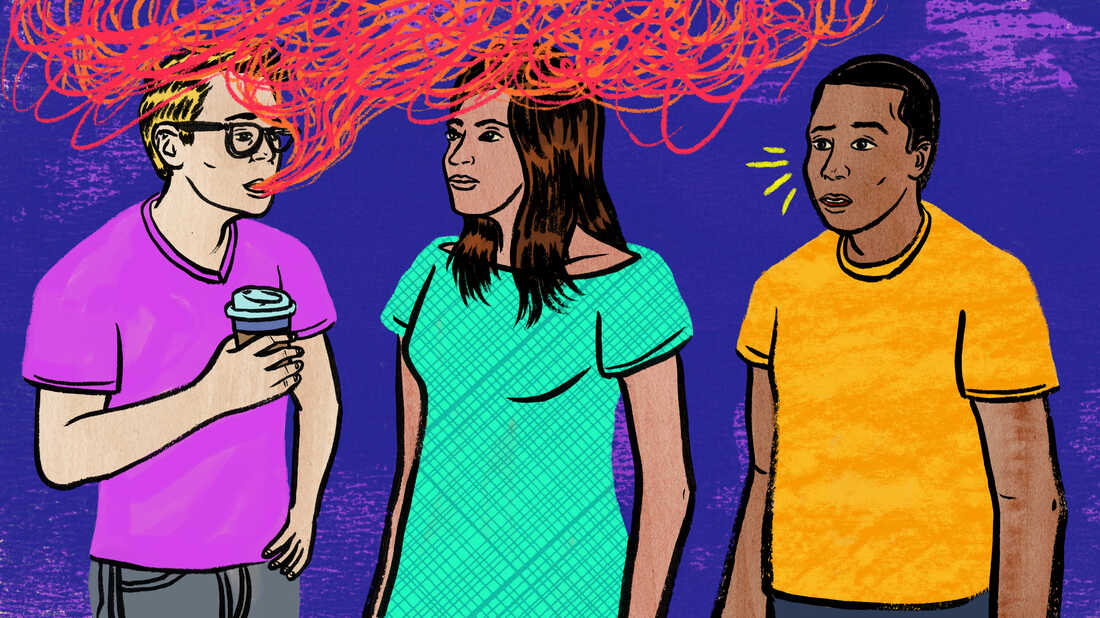
We've all been there — having fun relaxing with friends and family, when someone says something a little racially off. Sometimes it's subtle, like the friend who calls Thai food "exotic." Other times it's more overt, like that in-law who's always going on about "the illegals."
In any case, it can be hard to know how to respond. Even the most level-headed among us have faltered trying to navigate the fraught world of racial awkwardness.
So what exactly do you do? We delve into the issue on this week's episode of the Code Switch podcast, featuring writer Nicole Chung and Code Switch's Shereen Marisol Meraji, Gene Demby and Karen Grigsby Bates.
We also asked some folks to write about what runs through their minds during these tense moments, and how they've responded (or not). Their reactions ran the gamut from righteous indignation to total passivity, but in the wake of these uncomfortable comments, everyone seemed to walk away wishing they'd done something else.
Aaron E. Sanchez
It was the first time my dad visited me at college, and he had just dropped me off at my dorm. My suitemate walked in and sneered.
"Was that your dad?" he asked. "He looks sooo Mexican."

Aaron E. Sanchez is a Texas-based writer who focuses on issues of race, politics and popular culture from a Latino perspective. Courtesy of Aaron Sanchez hide caption
He kept laughing about it as he left my room.
I was caught off-guard. Instantly, I grew self-conscious, not because I was ashamed of my father, but because my respectability politics ran deep. My appearance was supposed to be impeccable and my manners unimpeachable to protect against stereotypes and slights. I felt exposed.
To be sure, when my dad walked into restaurants and stores, people almost always spoke to him in Spanish. He didn't mind. The fluidity of his bilingualism rarely failed him. He was unassuming. He wore his working-class past on his frame and in his actions. He enjoyed hard work and appreciated it in others. Yet others mistook him for something altogether different.
People regularly confused his humility for servility. He was mistaken for a landscape worker, a janitor, and once he sat next to a gentleman on a plane who kept referring to him as a "wetback." He was a poor Mexican-American kid who grew up in the Segundo Barrio of El Paso, Texas, for certain. But he was also an Air Force veteran who had served for 20 years. He was an electrical engineer, a proud father, an admirable storyteller, and a pretty decent fisherman.
I didn't respond to my suitemate. To him, my father was a funny caricature, a curio he could pick up, purchase and discard. And as much as it was hidden beneath my elite, liberal arts education, I was a novelty to him too, an even rarer one at that. Instead of a serape, I came wrapped in the trappings of middle-classness, a costume I was trying desperately to wear convincingly.
That night, I realized that no clothing or ill-fitting costume could cover us. Our bodies were incongruous to our surroundings. No matter how comfortable we were in our skins, our presence would make others uncomfortable.
Karen Good Marable
When the Q train pulled into the Cortelyou Road station, it was dark and I was tired. Another nine hours in New York City, working in the madness that is Midtown as a fact-checker at a fashion magazine. All day long, I researched and confirmed information relating to beauty, fashion and celebrity, and, at least once a day, suffered an editor who was openly annoyed that I'd discovered an error. Then, the crush of the rush-hour subway, and a dinner obligation I had to fulfill before heading home to my cat.
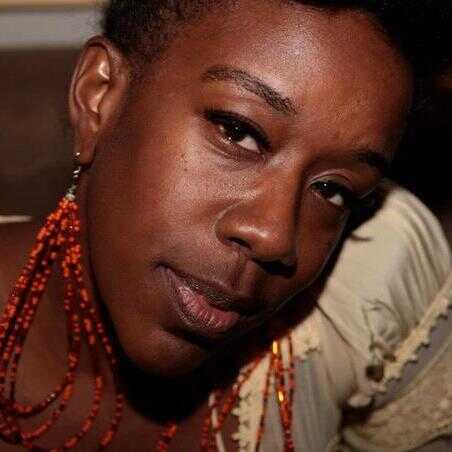
Karen Good Marable is a writer living in New York City. Her work has been featured in publications like The Undefeated and The New Yorker. Courtesy of Karen Good Marable hide caption
The train doors opened and I turned the corner to walk up the stairs. Coming down were two girls — free, white and in their 20s . They were dancing as they descended, complete with necks rolling, mouths pursed — a poor affectation of black girls — and rapping as they passed me:
Now I ain't sayin she a golddigger/But she ain't messin' with no broke niggas!
That last part — broke niggas — was actually less rap, more squeals that dissolved into giggles. These white girls were thrilled to say the word publicly — joyously, even — with the permission of Kanye West.
I stopped, turned around and stared at them. I envisioned kicking them both squarely in their backs. God didn't give me telekinetic powers for just this reason. I willed them to turn around and face me, but they did not dare. They bopped on down the stairs and onto the platform, not evening knowing the rest of the rhyme.
Listen: I'm a black woman from the South. I was born in the '70s and raised by parents — both educators — who marched for their civil rights. I never could get used to nigga being bandied about — not by the black kids and certainly not by white folks. I blamed the girls' parents for not taking over where common sense had clearly failed. Hell, even radio didn't play the nigga part.
I especially blamed Kanye West for not only making the damn song, but for having the nerve to make nigga a part of the damn hook.
Life in NYC is full of moments like this, where something happens and you wonder if you should speak up or stay silent (which can also feel like complicity). I am the type who will speak up . Boys (or men) cussing incessantly in my presence? Girls on the train cussing around my 70-year-old mama? C'mon, y'all. Do you see me? Do you hear yourselves? Please. Stop.
But on this day, I just didn't feel like running down the stairs to tap those girls on the shoulder and school them on what they damn well already knew. On this day, I just sighed a great sigh, walked up the stairs, past the turnstiles and into the night.
Robyn Henderson-Espinoza
When I was 5 or 6, my mother asked me a question: "Does anyone ever make fun of you for the color of your skin?"
This surprised me. I was born to a Mexican woman who had married an Anglo man, and I was fairly light-skinned compared to the earth-brown hue of my mother. When she asked me that question, I began to understand that I was different.

Robyn Henderson-Espinoza is a visiting assistant professor of ethics at the Pacific School of Religion in Berkeley, Calif. Courtesy of Robyn Henderson-Espinoza hide caption
Following my parents' divorce in the early 1980s, I spent a considerable amount of time with my father and my paternal grandparents. One day in May of 1989, I was sitting at my grandparents' dinner table in West Texas. I was 12. The adults were talking about the need for more laborers on my grandfather's farm, and my dad said this:
"Mexicans are lazy."
He called the undocumented workers he employed on his 40 acres "wetbacks." Again and again, I heard from him that Mexicans always had to be told what to do. He and friends would say this when I was within earshot. I felt uncomfortable. Why would my father say these things about people like me?
But I remained silent.
It haunts me that I didn't speak up. Not then. Not ever. I still hear his words, 10 years since he passed away, and wonder whether he thought I was a lazy Mexican, too. I wish I could have found the courage to tell him that Mexicans are some of the hardest-working people I know; that those brown bodies who worked on his property made his lifestyle possible.
As I grew in experience and understanding, I was able to find language that described what he was doing: stereotyping, undermining, demonizing. I found my voice in the academy and in the movement for black and brown lives.
Still, the silence haunts me.
Channing Kennedy
My 20s were defined in no small part by a friendship with a guy I never met. For years, over email and chat, we shared everything with each other, and we made great jokes. Those jokes — made for each other only — were a foundational part of our relationship and our identities. No matter what happened, we could make each other laugh.

Channing Kennedy is an Oakland-based writer, performer, media producer and racial equity trainer. Courtesy of Channing Kennedy hide caption
It helped, also, that we were slackers with spare time, but eventually we both found callings. I started working in the social justice sector, and he gained recognition in the field of indie comics. I was proud of my new job and approached it seriously, if not gracefully. Before I took the job, I was the type of white dude who'd make casually racist comments in front of people I considered friends. Now, I had laid a new foundation for myself and was ready to undo the harm I'd done pre-wokeness.
And I was proud of him, too, if cautious. The indie comics scene is full of bravely offensive work: the power fantasies of straight white men with grievances against their nonexistent censors, put on defiant display. But he was my friend, and he wouldn't fall for that.
One day he emailed me a rough script to get my feedback. At my desk, on a break from deleting racist, threatening Facebook comments directed at my co-workers, I opened it up for a change of pace.
I got none. His script was a top-tier, irredeemable power fantasy — sex trafficking, disability jokes, gendered violence, every scene's background packed with commentary-devoid, racist caricatures. It also had a pop culture gag on top, to guarantee clicks.
I asked him why he'd written it. He said it felt "important." I suggested he shelve it. He suggested that that would be a form of censorship. And I realized this: My dear friend had created a racist power fantasy about dismembering women, and he considered it bravely offensive.
I could have said that there was nothing brave about catering to the established tastes of other straight white comics dudes. I could have dropped any number of half-understood factoids about structural racism, the finishing move of the recently woke. I could have just said the jokes were weak.
Instead, I became cruel to him, with a dedication I'd previously reserved for myself.
Over months, I redirected every bit of our old creativity. I goaded him into arguments I knew would leave him shaken and unable to work. I positioned myself as a surrogate parent (so I could tell myself I was still a concerned ally) then laughed at him. I got him to escalate. And, privately, I told myself it was me who was under attack, the one with the grievance, and I cried about how my friend was betraying me.
I wanted to erase him (I realized years later) not because his script offended me, but because it made me laugh. It was full of the sense of humor we'd spent years on — not the jokes verbatim, but the pacing, structure, reveals, go-to gags. It had my DNA and it was funny. I thought I had become a monster-slayer, but this comic was a monster with my hands and mouth.
After years as the best of friends and as the bitterest of exes, we finally had a chance to meet in person. We were little more than acquaintances with sunk costs at that point, but we met anyway. Maybe we both wanted forgiveness, or an apology, or to see if we still had some jokes. Instead, I lectured him about electoral politics and race in a bar and never smiled.
- code switch

Want to create or adapt books like this? Learn more about how Pressbooks supports open publishing practices.
Essay #8. Anti-Racism May Be An Answer
There’s one thing about writing about racism today. There will never be a shortage of material. It seems there will always be someone, somewhere, who will eventually say something racist. Everyday people say racist things. Famous people say racist things. The difference is, the famous have more to lose than the rest of us–or do they? Because their racist rants oftentimes find their way into mainstream and social media, we find out about it sooner or later. The rest of us can say our racist comments in the privacy of our homes and among our friends. Remember when Hulk Hogan became the newest celebrity to add his name to the racist rant hall of fame? I liked the character Hulk Hogan. So, it saddened me to learn about his racist rant. If you remember, Hulk Hogan apparently got upset with his daughter after finding out she was dating a Black man. He then went on an “N” word rant, which was taped. The taping was 8 years prior but brought back to life and made public. From the news account, I remember listening to it and from a reporter who grew up loving Hulk Hogan, it was bad. The WWE (World Wrestling Entertainment) cut all ties with Hulk Hogan. I mean the WWE excommunicated him to the land of nonexistence. To his credit Hulk Hogan apologized profusely. But what else was he going to do?
Is the WWE’s punishment going to undo, un-hurt or fix any problems in the Black community? Is the WWE’s punishment going to help teach society not to say or do such racist things? The answer is no. Like I’ve said to you several times before, racism is an on-purpose act that must be undone, on-purpose. I think the WWE should have given Hulk Hogan a chance to undo his racist rant, by sending him to (in this case) a Black school or youth center and let him tell the kids and their parents why he’s sorry for what he said. I think WWE and Hulk Hogan should have gone into their pockets and fix a problem in a poor Black school district. I think the WWE and Hulk Hogan should have started an after-school tutoring program to help Black kids do better in their school. This would have been an anti-racist act. This would have started the process of un-doing racism. If Hulk Hogan had made racist comments about Mexican people, Asian people, Native Indian people, or women, then what I’m talking about would apply to those communities. The same goes for any other race or group of people that have been offended by racist and hateful acts or comments perpetrated by wealthy people or organizations.
My point is, apologies aren’t enough. With all the racist rants and acts that are going on in this country, nothing is being done to undo racism. Firing people who make racist, sexist or any other hateful comments, doesn’t do anything for those communities or people hurt by the comments. An anti-racism approach needs to be taken. These communities need to demand more than apologies. Firing people who make racist comments does not educate or re-educate anyone. If society stays uneducated, racism will continue; Headline: “Racist person fired! End of Racism!”–probably not.
From Racist to Non-Racist to Anti-Racist: Becoming a Part of the Solution Copyright © 2001, 2020 by Keith L. Anderson, PhD is licensed under a Creative Commons Attribution-NonCommercial-NoDerivatives 4.0 International License , except where otherwise noted.
Share This Book
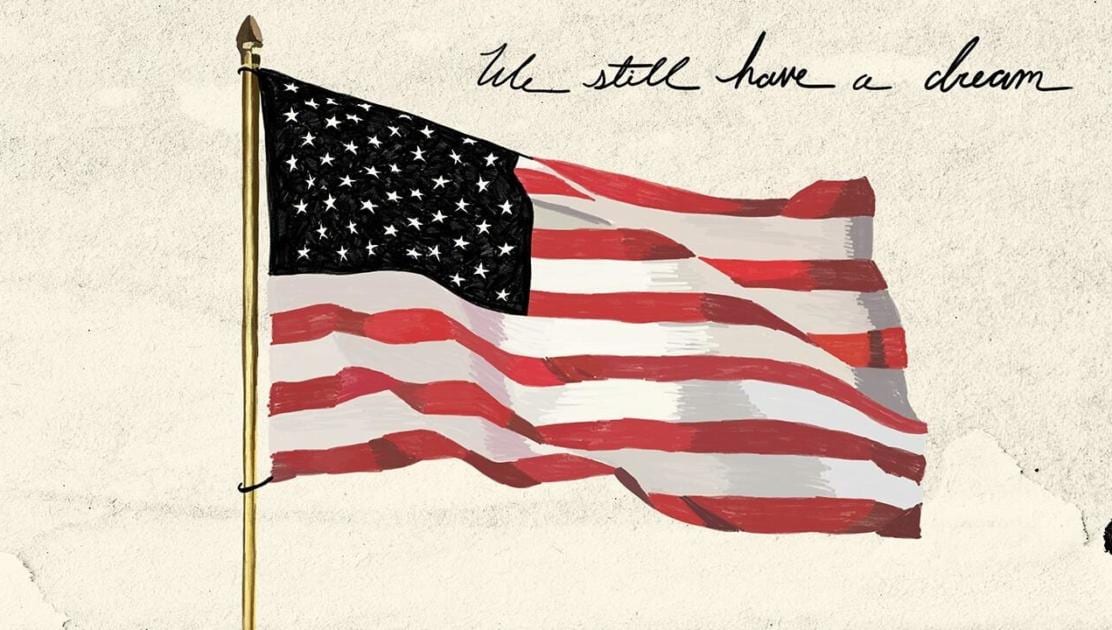
Ending Racism: How to Change the World in One Generation
An essay by garrison institute fellow justin michael williams.
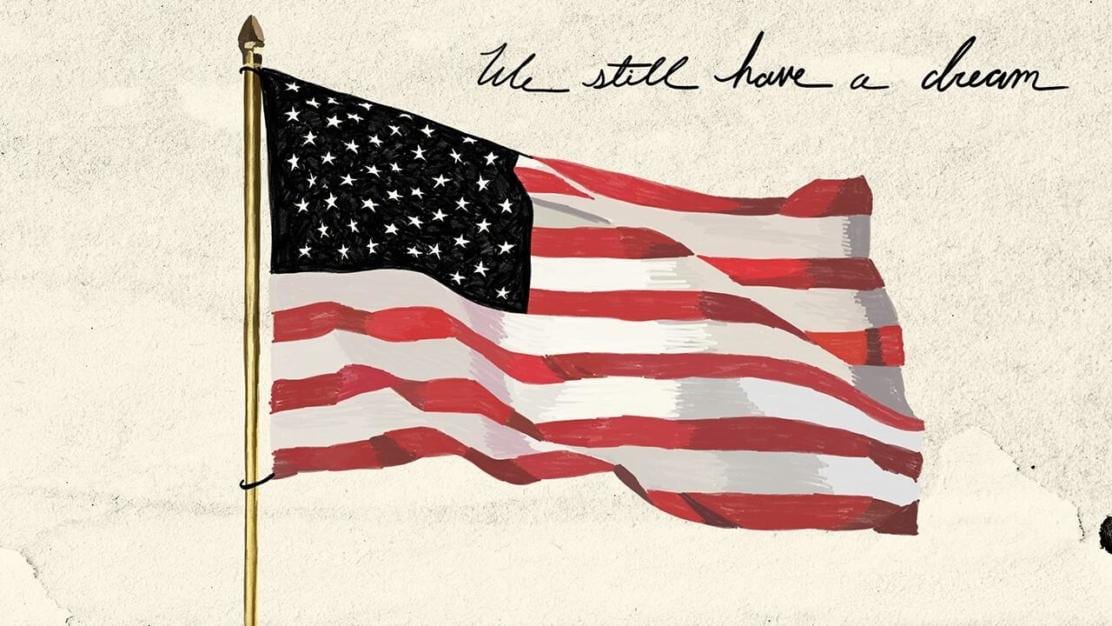
Almost every piece of work or literature that I’ve read on racism is built on one assumption: that it cannot end.
Or at best, that it will be a “lifelong fight.” That ending racism will be something that “will probably never happen in our generation.”
Most of the quotes you hear about the fight against racism sound something like this: “We used to say that ours is not the struggle of one day, one week, or one year. Ours is not the struggle of one judicial appointment or presidential term. Ours is the struggle of a lifetime , or maybe even many lifetimes, and each one of us in every generation must do our part.” ~ John Lewis, late civil rights leader and former U.S. Representative
But, if we all continue to say, “racism is something that can never end in our generation.” Then who the hell ever gets to take responsibility for ending it?
Enter: us.
We still have a dream. But we are the vessel for the dreams our ancestors were unable to dream.
The current work and research on anti-racism is phenomenal, and so is the tireless work that has been done by our ancestors for generations. But much of this work has one fatal flaw—it’s created from the automatic assumption (whether subconscious or conscious) that racism is unlikely to ever end . And if that’s our starting point, —if that’s the plateau from which we’re writing our books, creating our podcasts, and doing our activism and anti-racism work—then we’re missing a big opportunity here .
I’m not saying becoming an anti-racist or dismantling white supremacy isn’t important work. The current anti-racist and equality work has real impact— it’s saving live s. It’s creating systemic change. It’s bringing us together. And that matters— tremendously. I’m also not minimizing the centuries of incredible work done by civil rights leaders like John Lewis, Martin Luther King, Jr., Rosa Parks, Harriet Tubman, Patrisse Cullors, and the countless names we’ll never know. Without them, we would never have the opportunity to even consider ending racism.
What I am saying is this: Imagine how much more important our work becomes if it were done in a different context. If it were done not just as some sort of bootcamp “to be in a lifelong fight,” but with a common, united goal of actually ending racism in this generation .
Here’s what fighting against something looks like:
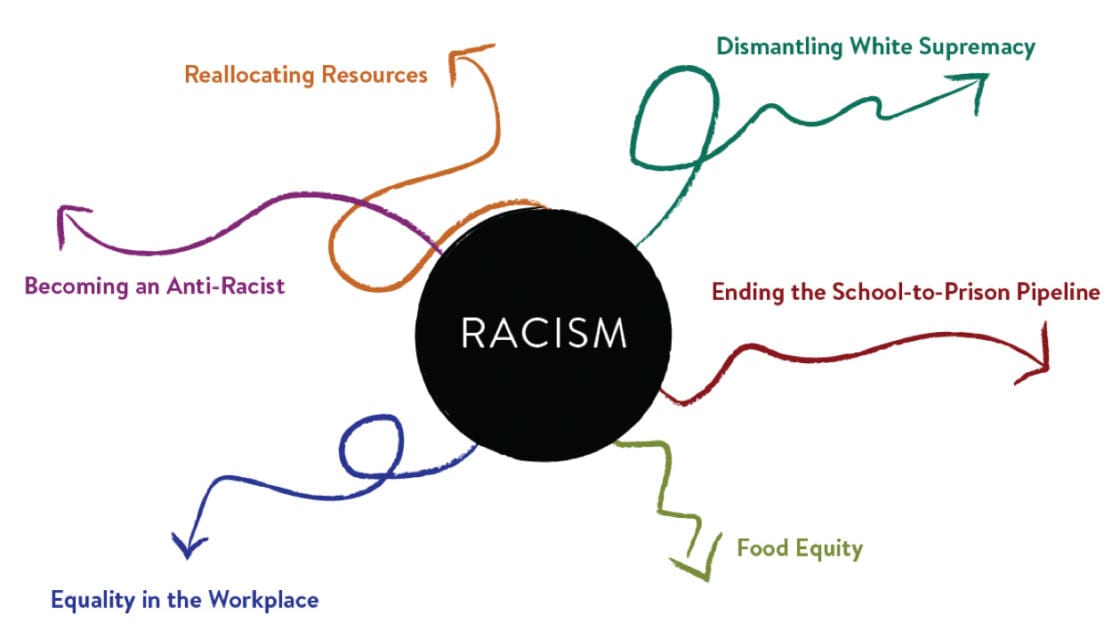
Here’s what moving toward something looks like:
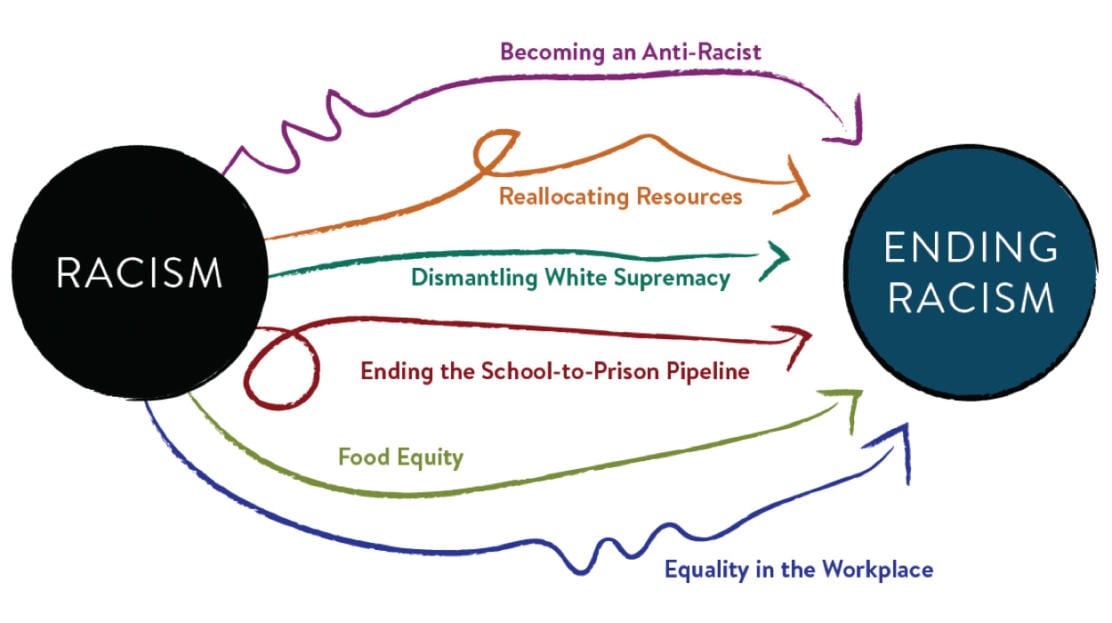
Congressman John Lewis was right. Our generation does have the opportunity to do something incredible. We have the opportunity to end racism. And to do it within this generation.
Notice what comes up for you when I say, “end racism.”
Notice what you feel when we put a timeline on it. Hopeful? Skeptical? Cynical?
Are you thinking to yourself, “Who does this guy think he is?” Are you wishing I would define race and racism? Hoping for a plan?
Good. That’s all part of our pathway forward.
But before we can begin to look at how to end racism —both systemic and internalized—I think it’s important that we understand what makes racism persist . Because once you’ve been stuck in a condition—once you’ve been working on the same recurring problem over and over to no end—it becomes important to shift the question from, “What is the problem?” to, “Why does the problem continue to persist in the first place?”
And in part, racism persists because of these five shared, yet individual assumptions:
- Racism is unavoidable.
- Race matters.
- “Those people” will never change.
- Real change takes a long time.
- We don’t know how to end it.
What do I mean by “shared, yet individual assumptions?
Before we can even get into breaking down any concepts about ending racism, we have to first explore what I mean by “shared, yet individual assumptions.” We must own and acknowledge that we, as individuals and as a collective, see things through a certain lens, or perspective. And if enough people agree on a certain perspective, then that perspective becomes our collective reality and belief. And I’m not talking about the woo-woo “law of attraction” stuff here (even though I love that stuff), I’m talking about perception and belief in the most tangible way.
For example, throughout much of ancient history, it was widely believed that the Earth was flat. People literally thought if they travelled far enough, they might fall off the edge of the Earth into an abyss of nothingness. Ancient civilizations from Greece and Egypt to Asia all believed this to be true, so they created a reality based upon that belief. We see it depicted in art, stories, religion, and ultimately, their shared beliefs about the world.
Now, I know you might be thinking, “We’ve evolved beyond that sort of foolery,” but let’s look at another untrue, yet harmless shared perspective that we all maintain today: our belief that the sun “sets.”
There’s a shared perspective that the sun sets, but the sun doesn’t really set. Think about it. Would the sun appear to set from the perspective of an astronaut who is far away from the Earth’s orbit? No. The Earth would be turning on its axis as it circles around the sun.
But from our shared perspective here on the planet, there’s an agreed-upon belief that the sun sets. On the foundation of this belief we’ve created our reality, the structure of our lives, and our world.
This leads me to an important point: Our world is created upon shared beliefs, even if those beliefs aren’t necessarily true.
So, to end racism , we must first own and acknowledge that we, as individuals and as a collective, see things through a sometimes-faulty lens. And if enough people choose to see through the same faulty lens (for example: Black people should be slaves, women are inferior), then that chosen perspective becomes the context through which we live our lives. In essence, if enough people share the same socially perceived illusions, those illusions cause a certain “way of life” to persist.
Now, with that in mind, let’s dismantle the five faulty perspectives that might be causing racism to persist.
#1: RACISM IS UNAVOIDABLE
Here’s the thing: It’s been proven by neuroscientists and psychologists that racism is learned —it’s not some automatic human condition that we’re born with. It’s not something that “just happens” as a result of putting a bunch of diverse people on a planet together. And I’m not sharing this with you as an idea or opinion. It is widely respected and proven by science that racism itself is not “a given.” It’s not unavoidable.
What is likely unavoidable, however, is the fact that we create what’s called “in-groups” and “out-groups” to keep ourselves safe. And terror management studies show that we have a tendency to treat people in our “in-group” more kindly and people in our “out group” more harshly. Yet, even with this scientific knowledge, the idea of using race as a way of defining our “in-group” and “out-group” is something we can eliminate—if we try.
But we the people are funny creatures. When we can’t figure out a quick solution to something, most of us label it as “unavoidable.” Inevitable. Unfortunate, but unlikely to change.
Yet, the idea that racism is “unavoidable” would be like saying the Holocaust was “unavoidable” or that American slavery was “unavoidable” or that refusing the LGBTQIA+ community the right to marry was “unavoidable.”
There’s a real danger in saying something is unavoidable, because we immediately absolve ourselves of taking responsibility to change it. We throw our hands up in the air and say, “Welp, can’t do anything about that.”
Can’t do anything about slavery… Can’t do anything about gay marriage… Can’t do anything about the spread of HIV… Can’t do anything about women’s rights…
Can’t do anything about racism…
Until somebody does.
#2: RACE MATTERS
I’m going to say something that’s sometimes hard for people to face, especially for my fellow people of color: Race is a complete fabrication of the human mind that’s used for power and control. It’s a social construct. A delusion. An imaginary truth (or alternative fact, if you will) that we’ve all continued to build our lives and civilizations upon.
“There is no such thing as race. None. There is just a human race—scientifically, anthropologically.” ~ Toni Morrison, novelist and professor
Now, I want to be very clear here: I don’t want for you to think for one second that I’m saying the effects of racism aren’t real. The trauma, the deaths, the lives lost, and the impact of racism—and the persistent collective belief in the idea of “race”—has had very real consequence s. It has created wars, dismantled countries, pitted religions against one another, and taken innocent Black and Brown lives for generations. Racism has caused incredible harm and trauma, which cannot be minimized.
I’m also not suggesting we put our cultures, values, and traditions into a Vitamix to make some vegan “we are all one” race-less smoothie. We don’t need to give up our culture, values, and traditions or become one big “melting pot” in order to end racism.
What we have the opportunity to do is far greater than that.
So, while this can be triggering or hard to stomach: The concept of race is literally IMAGINARY . Someone created it to gain and maintain power and control. And now we use it to control ourselves.
Race is not real.
Heritage is real. Culture is real. Tradition is real. Appropriation is real. Skin color is real. Trauma is real.
But race—not real.
Or… it’s as real as we make it.
For comparison, and to understand this more clearly, let’s consider the concept of gender. While sex is a biological fact of nature (we are born with different anatomy), gender is a cultural/historical interpretation . Gender is not a fact.
Skin color is a biological fact. Race is a cultural/historical interpretation.
Race is not a fact.
The thing is, I don’t think most of us actually care that much about race. Sure, we care about our traditions, cultures, ancestors, customs, languages, and especially our foods and religious landmarks—but race? REALLY?
Take a moment to think about it. If you could keep all of your traditions, customs, and practices, and the beauty of who we all are as differentiated unique humans with our own rituals and historical contexts; if you could continue assembling with like-minded individuals and celebrating your values and diversity; if you could keep all that and be treated equally with the humanity and dignity that is your birthright… how important would the individual concept of “race” be? What’s it for? What’s its function?
I gotta give it to the person who came up with the concept of “race” as a means to enforce power and control, because if their mission was to separate us—well, it worked.
Racism created race, not the other way around.
We were taught to care about race, so we did. Now, here we are, holding onto this “ thing ” that we don’t even really care about, but that’s causing us harm and pain and war and genocide and trauma over and over and over, and then saying…
“Even though we don’t care about this… Even though it’s not real… Even though it’s causing us harm… It’s unlikely to ever end.”
#3: “THOSE PEOPLE” WILL NEVER CHANGE
There is a commonly held belief that “those people” will never change, yet all throughout life, we can point to and tell stories of people who have changed. And not just “people out there,” but people in your life and family line.
I think about my buddy Greg, a white guy who grew up in Tennessee with a bunch of racist friends and family members who believed “Black people were stupid and lazy.” He said, “I used to believe that if Black people were making 20% less than whites, it’s because Black people must be working 20% less hard or weren’t as smart or capable… that something must be wrong with them genetically. Especially because I had always thought everyone had the same equal access to opportunity.”
Greg went on to say, “If I hadn’t dramatically fucked up my life… if I would’ve still been working in finance, with a house on a lake and a bunch of ‘toys’ like many of the people I grew up with, I would probably still be a white supremacist with a Confederate flag hanging from my truck.”
But that’s not the Greg I know. The Greg I know went through a massive change 15 years ago. And the reason we met was because I gave a talk at his company about ending racism and he came up to me afterward asking for resources to help his 5-year-old son grow up on the right side of history. Greg is committed to making sure his young white son doesn’t grow up racist—and even though Greg is doing his own anti-racist work, he was afraid he wasn’t equipped to teach his son properly. (I referred him to Layla Saad’s upcoming youth book and A Kids Book about Racism by Jelani Memory.) Greg, a man who used to be a racist white supremacist, is now someone who cares deeply about social justice. And the change didn’t happen when he was 12. It happened when he was 35.
We all know a Greg. They’re not rare. Point to your once-racist family members, your formerly tone-deaf coworkers, your used-to-be homophobic relatives, and the ways in which you’ve personally grown over the years.
People change all the time.
Racists are not exempt.
So, to me, the question becomes: What causes people to change?
Is it always for selfish reasons? For financial gain? Does it take a personal relationship? A direct experience? Do they need to “fuck up their life” like Greg did?
Fine. Instead of arguing over what are the “right” and “wrong” reasons for change, let’s use them to our advantage and create a model for racial healing where those conditions can be met, and met quickly.
#4: REAL CHANGE TAKES A LONG TIME
Okay, so let’s assume we’re in agreement here. But even if we all agree racism is avoidable, that we don’t really care about the concept of race, and that people can change, ending racism in our generation is still unrealistic, because real change takes a long time. Right?
You already know what’s coming…
But before I say it, let’s look at some of the most massive changes in recent human history. The “start” and “end” dates below represent unmistakable widespread shifts. Keep in mind, a generation is typically considered to be 20-25 years.
- (1973) The first phone call made on a handheld cellular phone ⭢ (1995) Widespread global use of mobile phones = 22 years
- (1991) Creation of the World Wide Web ⭢ (2001) Total widespread use of the internet = 10 years
- (1981) First documented case of HIV in the U.S. ⭢ (1995) Ability to detect, treat, and live with HIV = 14 years
- (2004) First U.S. state legalizes same-sex marriage ⭢ (2015) National legalization of same-sex marriage = 11 years
- (1831) First knowledge of slaves escaping through the Underground Railroad and the start of abolitionism ⭢ (1865) End of the Civil War = 34 years
- (1903) Wright brothers take first flight ⭢ (1920) Widespread commercial airline travel begins = 17 years
- (1929) Start of the Great Depression ⭢ (1945) End of the Great Depression = 16 years
- (1933) Hitler’s first position of leadership and the formation of the Nazi Party ⭢ (1945) End of the Holocaust = 12 years
- (1957) First satellite launched into space ⭢ (1969) Man lands on the moon = 12 years
So, I ask the question again: Does real change take a “long time”?
In almost all of these cases, it took less than one generation (20-25 years) to make widespread global change.
Does every change in human history fall into this timeline? Of course not. Were there years of unrewarded labor that came before the cited “start” dates. Absolutely. My intention is not to minimize the generations of work that have come before us, but to help you notice that once the ground has been prepared—which it is now—real change can happen. And it can happen fast .
So, let’s clean that smudge off of our dirty lens of perception and move on to the final point.
#5: WE DON’T KNOW HOW TO END IT
If we knew how to end racism, we would’ve already ended it… right?
(… do I even need to say it?)
The assumption that we “don’t know” how to end racism assumes there are no solutions. But that’s not true.
There are plenty of not just good , but excellent solutions for ending racism that were created by researchers, anti-racist scholars, universities, and entire college campuses dedicated to the cause. For generations, people have created models, systems, structures, and written The New York Times bestselling books— any of which could easily solve this problem. And not just hypothetically—there’s proof: We’ve seen the problem solved in micro but significant ways all throughout time—in our organizations, communities, and families.
We aren’t waiting for “better solutions”—just like we weren’t waiting for “better solutions” to end slavery and we didn’t need “better solutions” to end the Holocaust.
As a society, as individuals, and as a collective—we needed to be willing and ready .
And the same thing stands today.
We need to be willing and ready for our solutions to work.
“Are we so bound to our pain that we are not ready for liberation?” ~ Nico Cary, writer and mindfulness teacher
ENDING RACISM
So… if none of these things are causing racism to persist:
- If “Racism is unavoidable” is an inaccurate perspective, and
- “Race matters” is an inaccurate perspective, and
- “’Those people’ will never change” is an inaccurate perspective, and
- “Real change takes a long time” is an inaccurate perspective, and
- “We don’t know how to end it” is an inaccurate perspective…
… then what do we need to do to get racism to end?
Well, the same thing you do to get racism to persist— you change the shared perspective.
The purpose of this article was not to give you better solutions to end racism or a step-by-step plan on how to do it, it was to get you to consider that ending racism in this generation may not just be possible, but realistic— if we’re willing and ready .
One of my dear mentors, Jim Selman, always says, “There are lots of conversations ‘about’ change, but that’s different than conversations that actually change something.”
The key to any major shift in the world has always been the same: getting enough people to not just believe a cause “matters,” but to believe that change is possible . Researchers from the University of Pennsylvania and the University of London discovered in a 2018 study that it takes the support of just 25% of people to make a major social shift in the world.
You might be thinking, “Well, aren’t there already 25% of people who believe racism can end in this generation?”
I don’t think so.
I think more than 25% of people want racism to end. I think more than 25% of people believe racism is wrong . I think more than 25% of people think the fight against racism matters .
But I don’t think 25% of people have actually considered that they could be personally responsible for ending racism in this generation. I don’t think 25% of people think it can start with us. And it’s time to change that.
Our call now is simple—it’s to get people to believe.
We can’t fight to “end police brutality” just for the sake of “ending police brutality,” we need to fight against police brutality for the sake of ending racism. We shouldn’t be “dismantling white supremacy” just for the sake of “creating more diversity in the workplace” or “becoming nice white people,” we need to dismantle white supremacy with the intention of ending racism .
We cannot continue to fight for the liberation of our people just to have them encaged again; we must continue to fight for the liberation of our people to end racism in this generation .
If we want to have a breakthrough in ending racism, then we need to realize that it’s not going to happen unless we agree on a timeline for ending it. Saying it’s going to end “someday” is not a commitment. But if we put a stake in the ground and say we are going to end it in our generation, possibilities open up. A new reality emerges.
Racism can end —and it can end in this generation—if we believe it can. Because if we believe it can, we shift the context of the world.
WHAT DO WE DO NEXT?
The goal now is to get as many people as possible to consider that racism can and should end in this generation .
And like any meaningful change, we start by doing the work both internally and with our families, friends, colleagues, and communities. And ultimately, on a global scale—each of us spreading seeds of possibility to the corners of the earth that only we can reach.
You see, this is not about stopping the work that we’re already doing, this is about doing it with a new purpose, a new intention, a new meaning, and a realizable goal. This is about using every means available to us now and every means that becomes available to us in the future to move beyond resignation and fulfill our new, shared yet individual perspective that racism can—and will— end in this generation.
Here are five ways that you can help right now:
- Sign the pledge. We’ve created a Pledge to End Racism with a goal of getting 25% of the population to sign it. If we get 1.9 billion people to sign the pledge, we have enough power to end racism not just in the U.S., but throughout the world.
- Donate. We launched the Ending Racism Grant & Scholarship Fund to support vetted individuals and grassroots organizations who have taken the Pledge to End Racism. Donate or apply here .
- Stream this song as much as you can. All proceeds go straight to our mission to end racism.
- Show your support. After you sign the Pledge to End Racism , display the graphic on your website, social media, or on the bumper of your car. Remember, this is about spreading an idea.
- Share. This article is a free resource. Copy it, paste it, post it, debate it, and share it in your newsletters. Do whatever you want with it—but do it with the goal of ending racism.
And when an opportunity arises for you to end racism, you will. I can’t tell you exactly what you will do, because I don’t know exactly what opportunity will arise for you next, but when it comes—you will know. And you’ll have a choice to either end racism, or not. And you will .
I LEAVE YOU WITH THIS
My sister Shelly Tygielski, founder of Pandemic of Love , once said something so dear to me that I want to pass it along to you. She said, “There are two types of people in this world. The what if’s and the why not’s … don’t be a what if . They are paralyzed in their analysis. Be a why not . Why not me? Why not now? Why not us? Why not believe… and then see what happens next?”
So, the next time someone says racism can’t end, lovingly reply with: Why not? Then, send them this article.
We the people… we still have a dream. It’s a new dream.
We are the vessel for the dreams our ancestors were unable to dream.
We are exactly who was meant to be alive at this time.
We are enough.
And we rise—together.

Justin’s program The Liberation Experience brings people together across divides – learn more and get on the waitlist here . If you want to contact Justin directly, you can do so by clicking here .
Freedom Flag image illustrated by Victoria Cassinova Justin Michael Williams photo by Jamaal
Related Articles
Garrison institute fellowship director and fellows to present at 4th international conference on mindfulness, creating a wise work-life balance: relational sensemaking in leadership, introducing the garrison institute fellowship, one comment on “ending racism: how to change the world in one generation”.
Wow! I have goosebumps. I am passionate about wellness, the healing of black people and the eradication of racism, particularly anti-black racism. The idea of ending racism in one generation has given me tremendous inspiration and energy. Let’s do this!
Leave a Reply Cancel reply
Your email address will not be published. Required fields are marked *
This site uses Akismet to reduce spam. Learn how your comment data is processed .
Numbers, Facts and Trends Shaping Your World
Read our research on:
Full Topic List
Regions & Countries
- Publications
- Our Methods
- Short Reads
- Tools & Resources
Read Our Research On:
- Black Americans Have a Clear Vision for Reducing Racism but Little Hope It Will Happen
Many say key U.S. institutions should be rebuilt to ensure fair treatment
Table of contents.
- Black Americans see little improvement in their lives despite increased national attention to racial issues
- Few Black adults expect equality for Black people in the U.S.
- Black adults say racism and police brutality are extremely big problems for Black people in the U.S.
- Personal experiences with discrimination are widespread among Black Americans
- Black adults see voting as the most effective strategy for moving toward equality in the U.S.
- Some Black adults see Black businesses and communities as effective remedies for inequality
- Black Americans say race matters little when choosing political allies
- The legacy of slavery affects Black Americans today
- Most Black adults agree the descendants of enslaved people should be repaid
- The types of repayment Black adults think would be most helpful
- Responsibility for reparations and the likelihood repayment will occur
- Black adults say the criminal justice system needs to be completely rebuilt
- Black adults say political, economic and health care systems need major changes to ensure fair treatment
- Most Black adults say funding for police departments should stay the same or increase
- Acknowledgments
- Appendix: Supplemental tables
- The American Trends Panel survey methodology
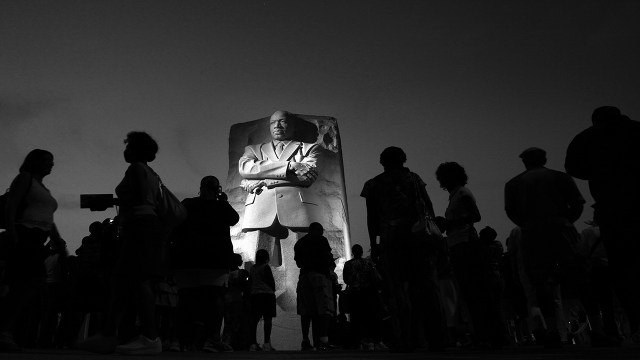
Pew Research Center conducted this analysis to understand the nuances among Black people on issues of racial inequality and social change in the United States. This in-depth survey explores differences among Black Americans in their views on the social status of the Black population in the U.S.; their assessments of racial inequality; their visions for institutional and social change; and their outlook on the chances that these improvements will be made. The analysis is the latest in the Center’s series of in-depth surveys of public opinion among Black Americans (read the first, “ Faith Among Black Americans ” and “ Race Is Central to Identity for Black Americans and Affects How They Connect With Each Other ”).
The online survey of 3,912 Black U.S. adults was conducted Oct. 4-17, 2021. Black U.S. adults include those who are single-race, non-Hispanic Black Americans; multiracial non-Hispanic Black Americans; and adults who indicate they are Black and Hispanic. The survey includes 1,025 Black adults on Pew Research Center’s American Trends Panel (ATP) and 2,887 Black adults on Ipsos’ KnowledgePanel. Respondents on both panels are recruited through national, random sampling of residential addresses.
Recruiting panelists by phone or mail ensures that nearly all U.S. Black adults have a chance of selection. This gives us confidence that any sample can represent the whole population (see our Methods 101 explainer on random sampling). Here are the questions used for the survey of Black adults, along with its responses and methodology .
The terms “Black Americans,” “Black people” and “Black adults” are used interchangeably throughout this report to refer to U.S. adults who self-identify as Black, either alone or in combination with other races or Hispanic identity.
Throughout this report, “Black, non-Hispanic” respondents are those who identify as single-race Black and say they have no Hispanic background. “Black Hispanic” respondents are those who identify as Black and say they have Hispanic background. We use the terms “Black Hispanic” and “Hispanic Black” interchangeably. “Multiracial” respondents are those who indicate two or more racial backgrounds (one of which is Black) and say they are not Hispanic.
Respondents were asked a question about how important being Black was to how they think about themselves. In this report, we use the term “being Black” when referencing responses to this question.
In this report, “immigrant” refers to people who were not U.S. citizens at birth – in other words, those born outside the U.S., Puerto Rico or other U.S. territories to parents who were not U.S. citizens. We use the terms “immigrant,” “born abroad” and “foreign-born” interchangeably.
Throughout this report, “Democrats and Democratic leaners” and just “Democrats” both refer to respondents who identify politically with the Democratic Party or who are independent or some other party but lean toward the Democratic Party. “Republicans and Republican leaners” and just “Republicans” both refer to respondents who identify politically with the Republican Party or are independent or some other party but lean toward the Republican Party.
Respondents were asked a question about their voter registration status. In this report, respondents are considered registered to vote if they self-report being absolutely certain they are registered at their current address. Respondents are considered not registered to vote if they report not being registered or express uncertainty about their registration.
To create the upper-, middle- and lower-income tiers, respondents’ 2020 family incomes were adjusted for differences in purchasing power by geographic region and household size. Respondents were then placed into income tiers: “Middle income” is defined as two-thirds to double the median annual income for the entire survey sample. “Lower income” falls below that range, and “upper income” lies above it. For more information about how the income tiers were created, read the methodology .
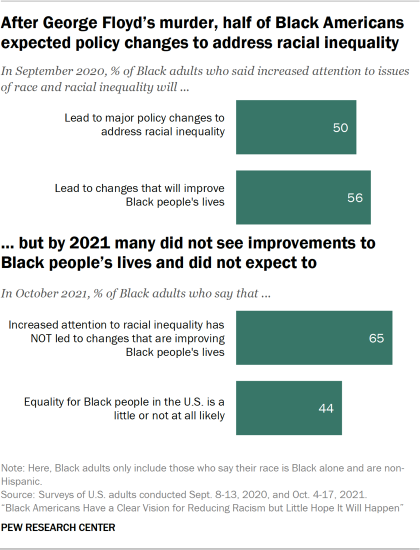
More than a year after the murder of George Floyd and the national protests, debate and political promises that ensued, 65% of Black Americans say the increased national attention on racial inequality has not led to changes that improved their lives. 1 And 44% say equality for Black people in the United States is not likely to be achieved, according to newly released findings from an October 2021 survey of Black Americans by Pew Research Center.
This is somewhat of a reversal in views from September 2020, when half of Black adults said the increased national focus on issues of race would lead to major policy changes to address racial inequality in the country and 56% expected changes that would make their lives better.
At the same time, many Black Americans are concerned about racial discrimination and its impact. Roughly eight-in-ten say they have personally experienced discrimination because of their race or ethnicity (79%), and most also say discrimination is the main reason many Black people cannot get ahead (68%).
Even so, Black Americans have a clear vision for how to achieve change when it comes to racial inequality. This includes support for significant reforms to or complete overhauls of several U.S. institutions to ensure fair treatment, particularly the criminal justice system; political engagement, primarily in the form of voting; support for Black businesses to advance Black communities; and reparations in the forms of educational, business and homeownership assistance. Yet alongside their assessments of inequality and ideas about progress exists pessimism about whether U.S. society and its institutions will change in ways that would reduce racism.
These findings emerge from an extensive Pew Research Center survey of 3,912 Black Americans conducted online Oct. 4-17, 2021. The survey explores how Black Americans assess their position in U.S. society and their ideas about social change. Overall, Black Americans are clear on what they think the problems are facing the country and how to remedy them. However, they are skeptical that meaningful changes will take place in their lifetime.
Black Americans see racism in our laws as a big problem and discrimination as a roadblock to progress
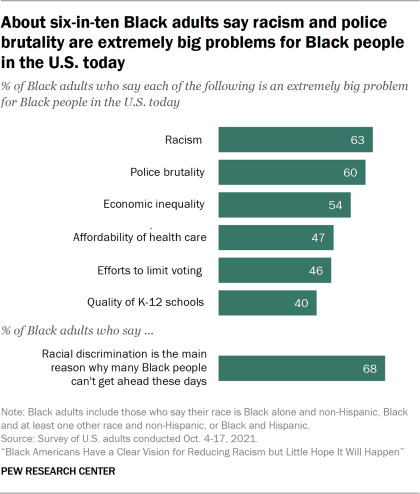
Black adults were asked in the survey to assess the current nature of racism in the United States and whether structural or individual sources of this racism are a bigger problem for Black people. About half of Black adults (52%) say racism in our laws is a bigger problem than racism by individual people, while four-in-ten (43%) say acts of racism committed by individual people is the bigger problem. Only 3% of Black adults say that Black people do not experience discrimination in the U.S. today.
In assessing the magnitude of problems that they face, the majority of Black Americans say racism (63%), police brutality (60%) and economic inequality (54%) are extremely or very big problems for Black people living in the U.S. Slightly smaller shares say the same about the affordability of health care (47%), limitations on voting (46%), and the quality of K-12 schools (40%).
Aside from their critiques of U.S. institutions, Black adults also feel the impact of racial inequality personally. Most Black adults say they occasionally or frequently experience unfair treatment because of their race or ethnicity (79%), and two-thirds (68%) cite racial discrimination as the main reason many Black people cannot get ahead today.
Black Americans’ views on reducing racial inequality
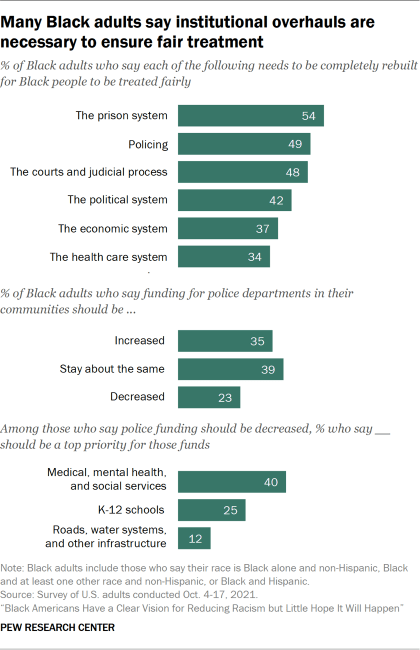
Black Americans are clear on the challenges they face because of racism. They are also clear on the solutions. These range from overhauls of policing practices and the criminal justice system to civic engagement and reparations to descendants of people enslaved in the United States.
Changing U.S. institutions such as policing, courts and prison systems
About nine-in-ten Black adults say multiple aspects of the criminal justice system need some kind of change (minor, major or a complete overhaul) to ensure fair treatment, with nearly all saying so about policing (95%), the courts and judicial process (95%), and the prison system (94%).
Roughly half of Black adults say policing (49%), the courts and judicial process (48%), and the prison system (54%) need to be completely rebuilt for Black people to be treated fairly. Smaller shares say the same about the political system (42%), the economic system (37%) and the health care system (34%), according to the October survey.
While Black Americans are in favor of significant changes to policing, most want spending on police departments in their communities to stay the same (39%) or increase (35%). A little more than one-in-five (23%) think spending on police departments in their area should be decreased.
Black adults who favor decreases in police spending are most likely to name medical, mental health and social services (40%) as the top priority for those reappropriated funds. Smaller shares say K-12 schools (25%), roads, water systems and other infrastructure (12%), and reducing taxes (13%) should be the top priority.
Voting and ‘buying Black’ viewed as important strategies for Black community advancement
Black Americans also have clear views on the types of political and civic engagement they believe will move Black communities forward. About six-in-ten Black adults say voting (63%) and supporting Black businesses or “buying Black” (58%) are extremely or very effective strategies for moving Black people toward equality in the U.S. Smaller though still significant shares say the same about volunteering with organizations dedicated to Black equality (48%), protesting (42%) and contacting elected officials (40%).
Black adults were also asked about the effectiveness of Black economic and political independence in moving them toward equality. About four-in-ten (39%) say Black ownership of all businesses in Black neighborhoods would be an extremely or very effective strategy for moving toward racial equality, while roughly three-in-ten (31%) say the same about establishing a national Black political party. And about a quarter of Black adults (27%) say having Black neighborhoods governed entirely by Black elected officials would be extremely or very effective in moving Black people toward equality.
Most Black Americans support repayment for slavery
Discussions about atonement for slavery predate the founding of the United States. As early as 1672 , Quaker abolitionists advocated for enslaved people to be paid for their labor once they were free. And in recent years, some U.S. cities and institutions have implemented reparations policies to do just that.
Most Black Americans say the legacy of slavery affects the position of Black people in the U.S. either a great deal (55%) or a fair amount (30%), according to the survey. And roughly three-quarters (77%) say descendants of people enslaved in the U.S. should be repaid in some way.
Black adults who say descendants of the enslaved should be repaid support doing so in different ways. About eight-in-ten say repayment in the forms of educational scholarships (80%), financial assistance for starting or improving a business (77%), and financial assistance for buying or remodeling a home (76%) would be extremely or very helpful. A slightly smaller share (69%) say cash payments would be extremely or very helpful forms of repayment for the descendants of enslaved people.
Where the responsibility for repayment lies is also clear for Black Americans. Among those who say the descendants of enslaved people should be repaid, 81% say the U.S. federal government should have all or most of the responsibility for repayment. About three-quarters (76%) say businesses and banks that profited from slavery should bear all or most of the responsibility for repayment. And roughly six-in-ten say the same about colleges and universities that benefited from slavery (63%) and descendants of families who engaged in the slave trade (60%).
Black Americans are skeptical change will happen
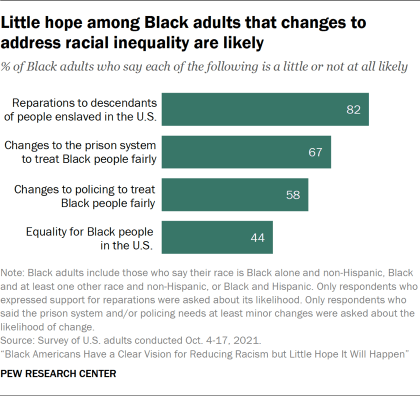
Even though Black Americans’ visions for social change are clear, very few expect them to be implemented. Overall, 44% of Black adults say equality for Black people in the U.S. is a little or not at all likely. A little over a third (38%) say it is somewhat likely and only 13% say it is extremely or very likely.
They also do not think specific institutions will change. Two-thirds of Black adults say changes to the prison system (67%) and the courts and judicial process (65%) that would ensure fair treatment for Black people are a little or not at all likely in their lifetime. About six-in-ten (58%) say the same about policing. Only about one-in-ten say changes to policing (13%), the courts and judicial process (12%), and the prison system (11%) are extremely or very likely.
This pessimism is not only about the criminal justice system. The majority of Black adults say the political (63%), economic (62%) and health care (51%) systems are also unlikely to change in their lifetime.
Black Americans’ vision for social change includes reparations. However, much like their pessimism about institutional change, very few think they will see reparations in their lifetime. Among Black adults who say the descendants of people enslaved in the U.S. should be repaid, 82% say reparations for slavery are unlikely to occur in their lifetime. About one-in-ten (11%) say repayment is somewhat likely, while only 7% say repayment is extremely or very likely to happen in their lifetime.
Black Democrats, Republicans differ on assessments of inequality and visions for social change

Party affiliation is one key point of difference among Black Americans in their assessments of racial inequality and their visions for social change. Black Republicans and Republican leaners are more likely than Black Democrats and Democratic leaners to focus on the acts of individuals. For example, when summarizing the nature of racism against Black people in the U.S., the majority of Black Republicans (59%) say racist acts committed by individual people is a bigger problem for Black people than racism in our laws. Black Democrats (41%) are less likely to hold this view.
Black Republicans (45%) are also more likely than Black Democrats (21%) to say that Black people who cannot get ahead in the U.S. are mostly responsible for their own condition. And while similar shares of Black Republicans (79%) and Democrats (80%) say they experience racial discrimination on a regular basis, Republicans (64%) are more likely than Democrats (36%) to say that most Black people who want to get ahead can make it if they are willing to work hard.
On the other hand, Black Democrats are more likely than Black Republicans to focus on the impact that racial inequality has on Black Americans. Seven-in-ten Black Democrats (73%) say racial discrimination is the main reason many Black people cannot get ahead in the U.S, while about four-in-ten Black Republicans (44%) say the same. And Black Democrats are more likely than Black Republicans to say racism (67% vs. 46%) and police brutality (65% vs. 44%) are extremely big problems for Black people today.
Black Democrats are also more critical of U.S. institutions than Black Republicans are. For example, Black Democrats are more likely than Black Republicans to say the prison system (57% vs. 35%), policing (52% vs. 29%) and the courts and judicial process (50% vs. 35%) should be completely rebuilt for Black people to be treated fairly.
While the share of Black Democrats who want to see large-scale changes to the criminal justice system exceeds that of Black Republicans, they share similar views on police funding. Four-in-ten each of Black Democrats and Black Republicans say funding for police departments in their communities should remain the same, while around a third of each partisan coalition (36% and 37%, respectively) says funding should increase. Only about one-in-four Black Democrats (24%) and one-in-five Black Republicans (21%) say funding for police departments in their communities should decrease.
Among the survey’s other findings:
Black adults differ by age in their views on political strategies. Black adults ages 65 and older (77%) are most likely to say voting is an extremely or very effective strategy for moving Black people toward equality. They are significantly more likely than Black adults ages 18 to 29 (48%) and 30 to 49 (60%) to say this. Black adults 65 and older (48%) are also more likely than those ages 30 to 49 (38%) and 50 to 64 (42%) to say protesting is an extremely or very effective strategy. Roughly four-in-ten Black adults ages 18 to 29 say this (44%).
Gender plays a role in how Black adults view policing. Though majorities of Black women (65%) and men (56%) say police brutality is an extremely big problem for Black people living in the U.S. today, Black women are more likely than Black men to hold this view. When it comes to criminal justice, Black women (56%) and men (51%) are about equally likely to share the view that the prison system should be completely rebuilt to ensure fair treatment of Black people. However, Black women (52%) are slightly more likely than Black men (45%) to say this about policing. On the matter of police funding, Black women (39%) are slightly more likely than Black men (31%) to say police funding in their communities should be increased. On the other hand, Black men are more likely than Black women to prefer that funding stay the same (44% vs. 36%). Smaller shares of both Black men (23%) and women (22%) would like to see police funding decreased.
Income impacts Black adults’ views on reparations. Roughly eight-in-ten Black adults with lower (78%), middle (77%) and upper incomes (79%) say the descendants of people enslaved in the U.S. should receive reparations. Among those who support reparations, Black adults with upper and middle incomes (both 84%) are more likely than those with lower incomes (75%) to say educational scholarships would be an extremely or very helpful form of repayment. However, of those who support reparations, Black adults with lower (72%) and middle incomes (68%) are more likely than those with higher incomes (57%) to say cash payments would be an extremely or very helpful form of repayment for slavery.
- Black adults in the September 2020 survey only include those who say their race is Black alone and are non-Hispanic. The same is true only for the questions of improvements to Black people’s lives and equality in the United States in the October 2021 survey. Throughout the rest of this report, Black adults include those who say their race is Black alone and non-Hispanic; those who say their race is Black and at least one other race and non-Hispanic; or Black and Hispanic, unless otherwise noted. ↩
Sign up for our weekly newsletter
Fresh data delivery Saturday mornings
Sign up for The Briefing
Weekly updates on the world of news & information
- Black Americans
- Criminal Justice
- Discrimination & Prejudice
- Economic Inequality
- Race, Ethnicity & Politics
A look at Black-owned businesses in the U.S.
8 facts about black americans and the news, black americans’ views on success in the u.s., among black adults, those with higher incomes are most likely to say they are happy, fewer than half of black americans say the news often covers the issues that are important to them, most popular, report materials.
- American Trends Panel Wave 97
1615 L St. NW, Suite 800 Washington, DC 20036 USA (+1) 202-419-4300 | Main (+1) 202-857-8562 | Fax (+1) 202-419-4372 | Media Inquiries
Research Topics
- Age & Generations
- Coronavirus (COVID-19)
- Economy & Work
- Family & Relationships
- Gender & LGBTQ
- Immigration & Migration
- International Affairs
- Internet & Technology
- Methodological Research
- News Habits & Media
- Non-U.S. Governments
- Other Topics
- Politics & Policy
- Race & Ethnicity
- Email Newsletters
ABOUT PEW RESEARCH CENTER Pew Research Center is a nonpartisan fact tank that informs the public about the issues, attitudes and trends shaping the world. It conducts public opinion polling, demographic research, media content analysis and other empirical social science research. Pew Research Center does not take policy positions. It is a subsidiary of The Pew Charitable Trusts .
Copyright 2024 Pew Research Center
Terms & Conditions
Privacy Policy
Cookie Settings
Reprints, Permissions & Use Policy

COMMENTS
At its core, The Help is an exploration of the ways in which racism pervaded every aspect of social life in 1960s Jackson, Mississippi - from Jim Crow laws that sanctioned discrimination and segregation as official policy to casual conversations between middle-class white women. In particular, the novel focuses on how white housewives justified the exploitation and emotional abuse of their ...
The Help , overall, effectively portrays the magnitude to which racial discrimination impacted the lives of many African Americans in the 1960s through the use of specific visual and audio techniques, including editing, sound design, mise en scene, cinematography, and visual design. During the 1960s, when The Help is set, the civil rights ...
The Help was based on the novel of the same name by Kathryn Stokett. In 1960s Mississippi, white families employed African American women to help them take care of children, do housework, and so on. These women called "the help". Three main characters of the movie are a young white women Miss Skeeter and two maids, Aibileen and Minny.
Full Book Analysis. The Help takes place between the summers of 1962 and 1964 in Jackson, Mississippi. Set against the backdrop of the civil rights movement, the novel focuses on a reckoning on race and segregation in a far more intimate sphere than the national stage: the home. Alternating between the perspectives of two Black maids, Aibileen ...
Race and Racism. Racism manifests in the lives of the black maids in a number of ways: they are denied opportunities for educational or professional advancement, they perform repetitive work for white families, they must curtail their speech to prevent violence, and they must use separate facilities. ... Essays for The Help. The Help essays are ...
Footnotes. This is an indication of widespread racism in 20 th century America.; The loss of Constantine and the ill-treatment of Negro help compel Phelan to write a book about the daily lives of Jackson's maidservants.; These are just examples of violent groups operating on the basis of racial and ethnic profiling.
The Help is a novel by Kathryn Stockett that was published in 2009 and later turned into a film in 2011. Set in Jackson, Mississippi in the early stages of the Civil Rights Movement (1962-1964), The Help follows the story of three women (two black women, and one white woman) who come together to anonymously publish a book called The Help.
In " Dangerous White Stereotypes " (Op-Ed, Aug. 29), Patricia A. Turner argues that the white characters in the film "The Help" who supported racist practices were portrayed as "bad ...
Stockett makes frequent mention of classic works of Southern literature in The Help, which situates her novel in a literary tradition of examining the realities of racism in the South.In many ways, The Help responds to and refutes Margaret Mitchell's Gone with the Wind and its representation of Mammy, an outspoken but matronly black slave and caregiver who faithfully and happily serves her ...
In The Help, a film that is based on a novel of the same name, the society of Mississippi in the 1960s is rightfully described as explicitly racist, which appears to limit the application of the concept of colorblindness to the story.However, an analysis of the film demonstrates that the explicitly racist characters tend to employ some of the frames of colorblind racism to justify their ideas ...
At its core, The Help is an exploration of the ways in which racism pervaded every aspect of social life in 1960s Jackson, Mississippi - from Jim Crow laws that sanctioned discrimination and segregation as official policy to casual conversations between middle-class white women. In particular, the novel focuses on how white housewives justified the exploitation and emotional abuse of their ...
Many creators in the fields of literature and cinematography have dedicated their works to this question. The current paper shall discuss the issues of racism and prejudice in two brilliant pieces of art: Kathryn Stockett's novel "The Help" and the movie "Gone with the Wind" directed by Victor Fleming. We will write a custom essay on ...
The Help Explains That Racism Is Taught, Not Inherent Anonymous 11th Grade. The Help follows the lives of two black maids working for white women during the 1960's. While helping write a book about their experiences, Aibileen continues to assist her employer Elizabeth, and watches over Elizabeth's daughter, Mae Mobley.
The Help Essay Questions. 1. The Help is very critical of the organized racial segregation of the 1960s, but some people have alleged that this novel perpetuates a subtler version of racism. They argue that the novel highlights the ungrammatical speech of the black maids, and makes their story secondary to that of a white woman (Skeeter).
The theme that attracted the most attention is racism and segregation. For centuries, equality has been an ongoing obstacle, whether it be race, gender, religion, segregation, special needs etc. Overall, the main theme depicted in The Help is race and segregation. In the 1960s, Jackson Mississippi happened to be an area where racism was openly ...
In the week since its release, The Help, a movie telling the story of a group of black maids in the South in the early 1960s, has been derided repeatedly in blog posts and reviews as a lazy ...
Stanford scholars examine systemic racism, how to advance racial justice in America. Black History Month is an opportunity to reflect on the Black experience in America and examine continuing ...
"Fighting racism is going to be an ongoing struggle and battle. As we continue to resist hate, we also need to find ways to support each other and to be increasingly collaborative." Defining and documenting racism. In recent years, psychologists have helped redefine the way we understand racism as a society.
The Help': Movie Analysis Essay. This essay sample was donated by a student to help the academic community. Papers provided by EduBirdie writers usually outdo students' samples. The Help adaptation of the novel of the same name was released on large screens in 2011, directed by Tate Taylor. According to IMDb, the film's rating is 8 on a scale ...
Here are the best tips to help make your racism essay stand out: Consider the historical causes of racism. Papers on racism often focus on discrimination and equality in modern society. Digging a bit deeper and highlighting the origins of racism will make your essay more impressive. Check academic resources on the subject to see how racism was ...
We delve into the issue on this week's episode of the Code Switch podcast, featuring writer Nicole Chung and Code Switch's Shereen Marisol Meraji, Gene Demby and Karen Grigsby Bates. We also asked ...
Essay #8. Anti-Racism May Be An Answer There's one thing about writing about racism today. There will never be a shortage of material. It seems there will always be someone, somewhere, who will eventually say something racist. Everyday people say racist things. Famous people say racist things.
An essay by Garrison Institute Fellow Justin Michael Williams. Almost every piece of work or literature that I've read on racism is built on one assumption: that it cannot end. Or at best, that it will be a "lifelong fight.". That ending racism will be something that "will probably never happen in our generation.". Most of the quotes ...
The terms "Black Americans," "Black people" and "Black adults" are used interchangeably throughout this report to refer to U.S. adults who self-identify as Black, either alone or in combination with other races or Hispanic identity.. Throughout this report, "Black, non-Hispanic" respondents are those who identify as single-race Black and say they have no Hispanic background.